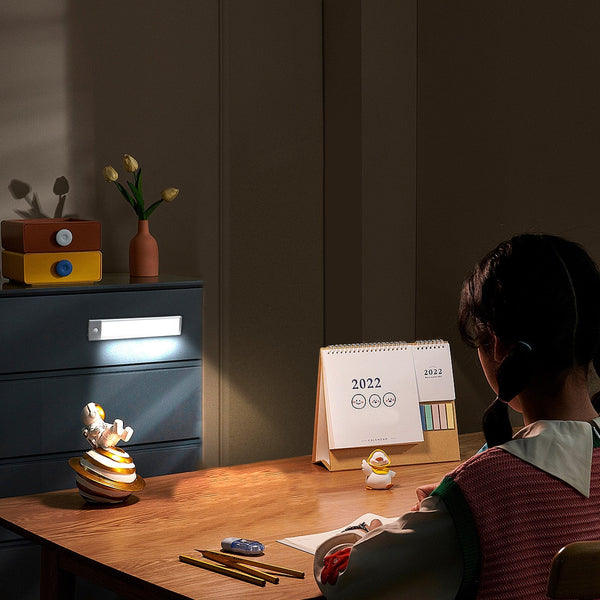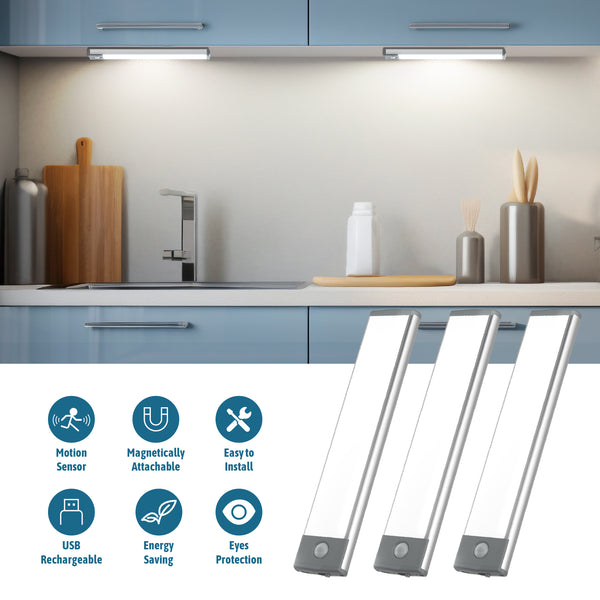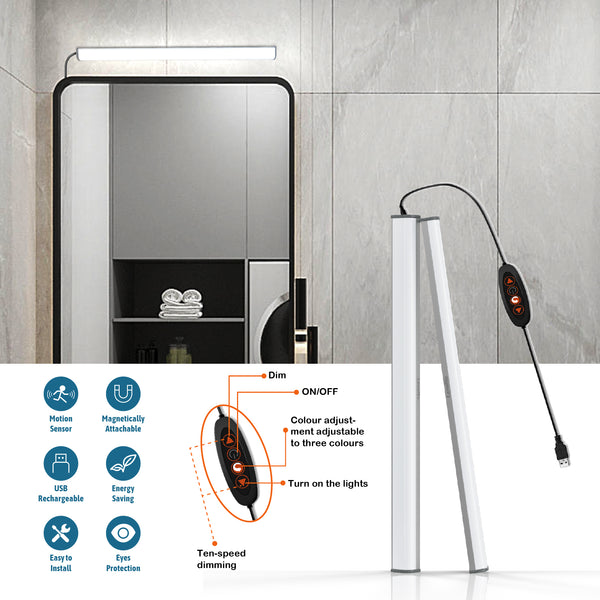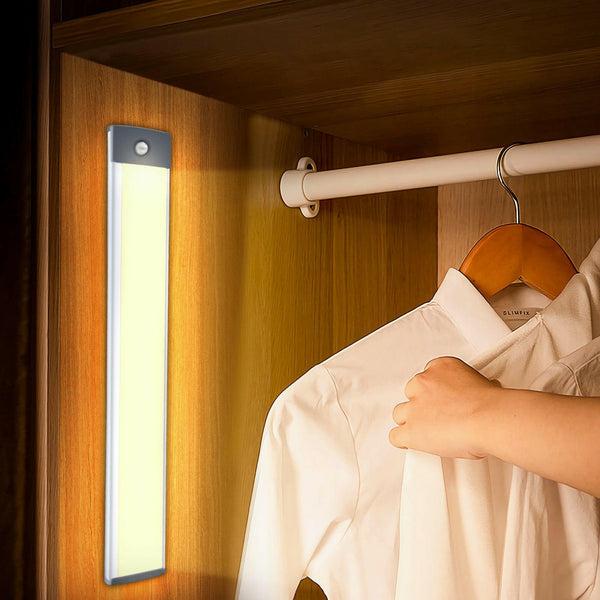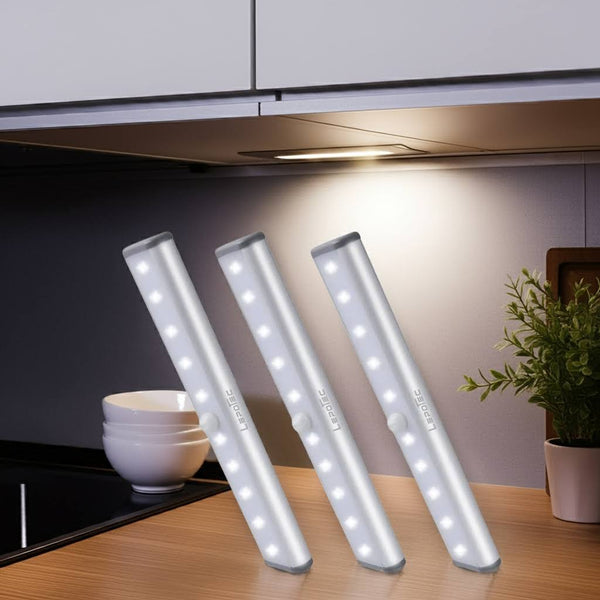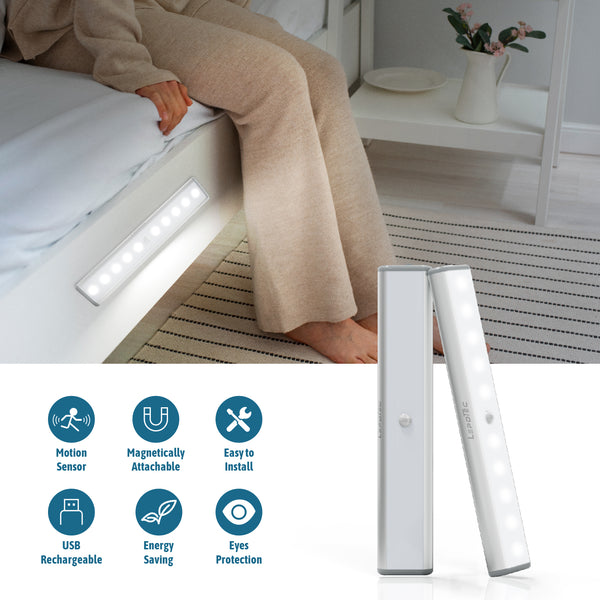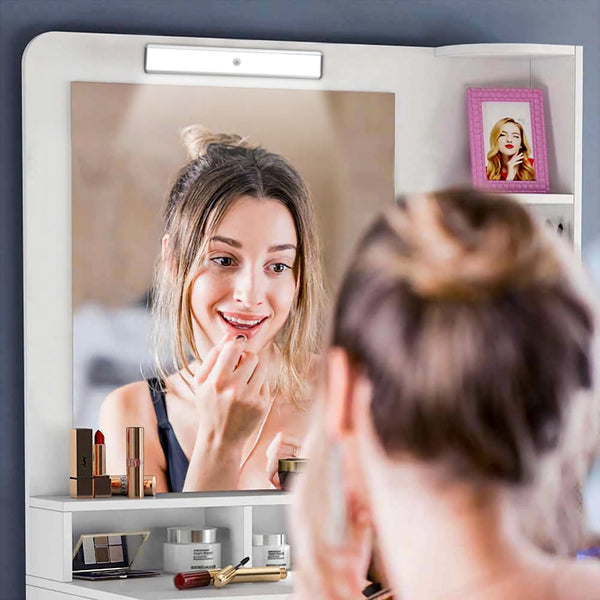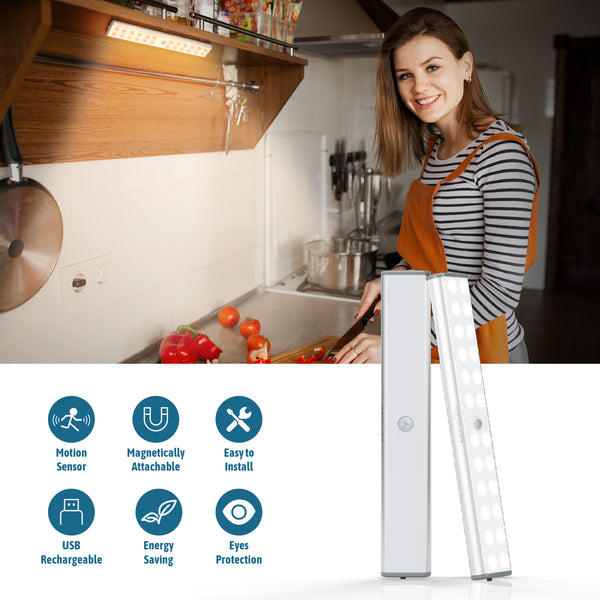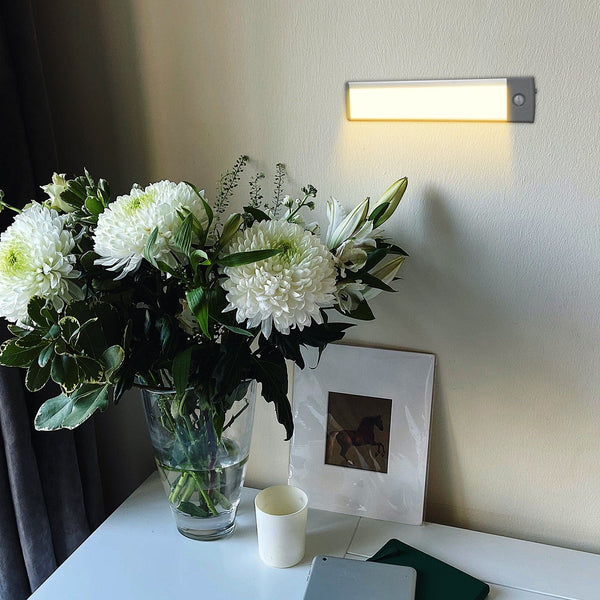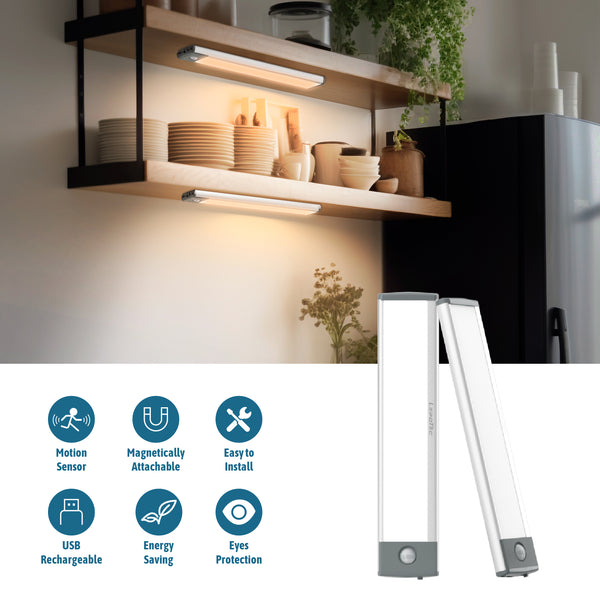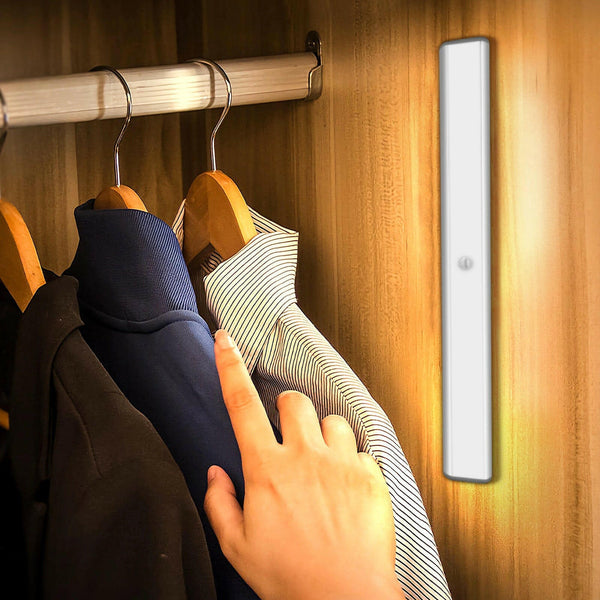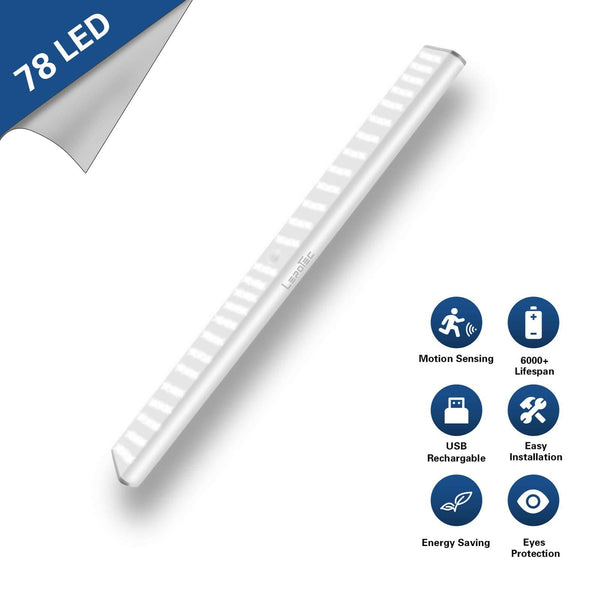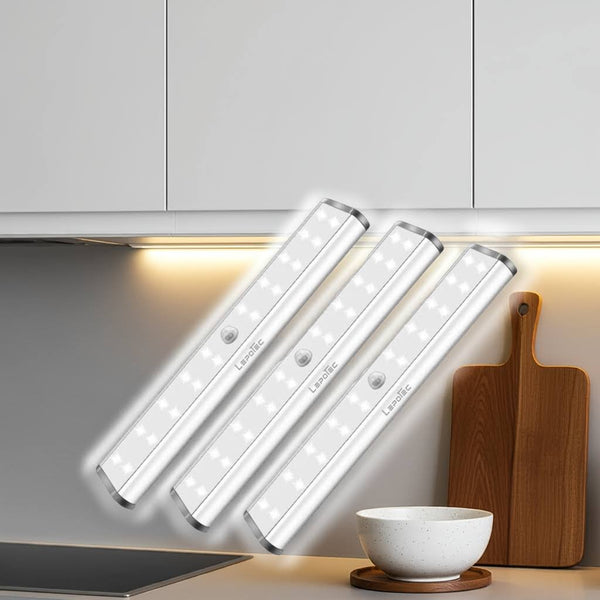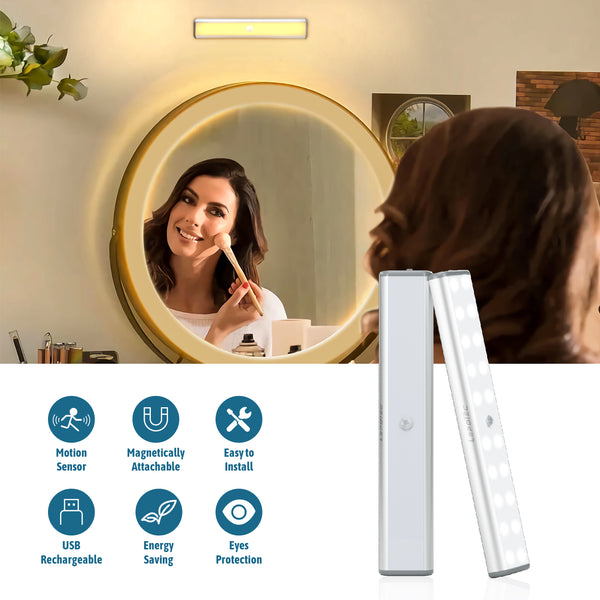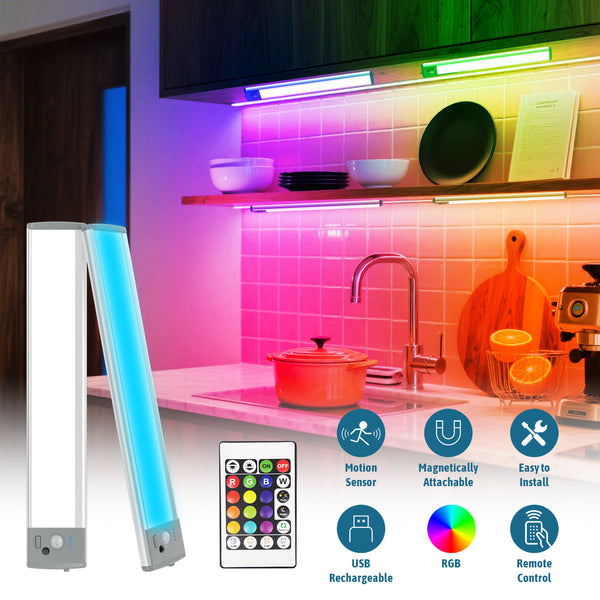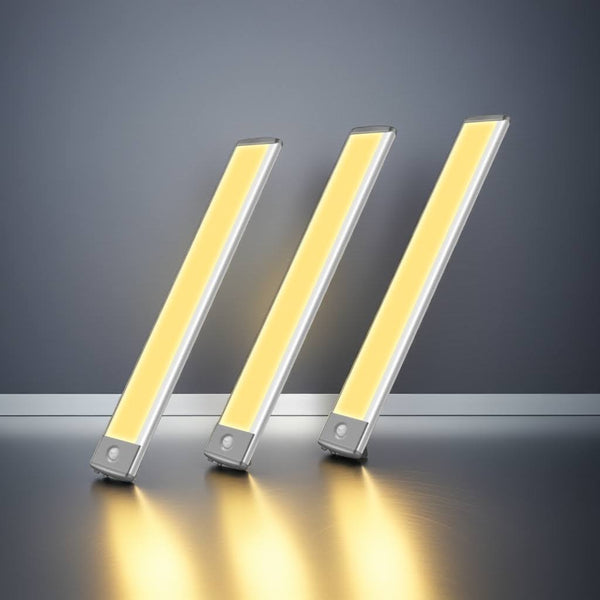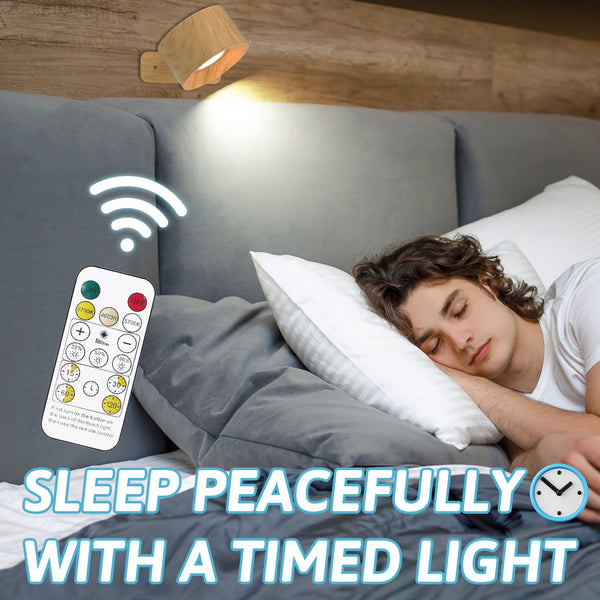When you're searching for the perfect lighting solution to illuminate your kitchen countertops, closets, or workspace, under cabinet motion sensor lights represent the pinnacle of modern convenience and energy efficiency. The global under cabinet lighting market, valued at $913.1 million in 2025, is experiencing unprecedented growth as homeowners increasingly recognize the transformative power of wireless, rechargeable LED lighting solutions [1]. This comprehensive guide will help you navigate the world of motion sensors under cabinet lights, with a particular focus on why Lepotec has emerged as the trusted choice for over 120,000 satisfied customers worldwide.
The evolution of under cabinet lighting has been remarkable. Gone are the days of complicated hardwired installations that required professional electricians and significant renovation work. Today's best rechargeable under cabinet lighting systems offer tool-free installation, USB charging capabilities, and intelligent motion detection that automatically illuminates your space exactly when you need it. Whether you're preparing meals in your kitchen at dawn, searching through your closet in the evening, or working in your garage workshop, motion sensor under cabinet lights provide instant, hands-free illumination that enhances both functionality and safety.
The decision to buy under cabinet motion sensor lights represents more than just a lighting upgrade—it's an investment in convenience, energy efficiency, and modern living. With the motion sensor lighting market projected to reach $4.25 billion by 2031, growing at a compound annual growth rate of 10.5% [2], it's clear that consumers are embracing this technology for its practical benefits and long-term value. This growth is driven by increasing awareness of energy efficiency, the desire for smart home integration, and the undeniable convenience of hands-free operation.
Lepotec, established in 2009 with over 15 years of expertise in LED lighting solutions, has positioned itself at the forefront of this revolution. As a U.S. brand supported by advanced Chinese manufacturing capabilities with full OEM and ODM capacity, Lepotec combines American innovation with precision engineering to deliver products that consistently exceed customer expectations. The company's commitment to quality is evidenced by comprehensive certifications including FCC, CE, and RoHS compliance, ensuring that every product meets the highest standards for safety, performance, and environmental responsibility.
What sets modern under cabinet motion sensor lights apart from traditional lighting solutions is their sophisticated integration of multiple technologies. Advanced PIR (Passive Infrared) sensors detect movement within a 5.5-foot range, instantly activating bright LED arrays that can contain anywhere from 10 to 104 individual LEDs depending on the model [3]. These systems incorporate rechargeable lithium-ion batteries that can provide up to 30 hours of continuous operation on a single charge, while USB-C charging ports ensure fast, convenient recharging using standard cables.
The versatility of wireless LED cabinet lights for sale today extends far beyond traditional kitchen applications. Modern homeowners are discovering innovative uses in RVs and mobile homes, where power efficiency and easy installation are paramount. Workshop and garage applications benefit from the bright, focused illumination that motion sensors provide, automatically lighting work areas without the need to fumble for switches with dirty or occupied hands. Closets and wardrobes are transformed from dark, difficult-to-navigate spaces into well-lit, organized areas where finding specific items becomes effortless.
The technology behind motion sensor under cabinet lights with USB charging represents a convergence of energy-efficient LED technology, intelligent sensor systems, and modern battery management. Unlike older systems that relied on disposable batteries or complex hardwired connections, today's rechargeable solutions offer the perfect balance of performance, convenience, and environmental responsibility. The shift toward USB charging has been particularly significant, as it eliminates the need for proprietary charging systems and allows users to charge their lights using the same cables they use for smartphones and other devices.
Installation simplicity has become a defining characteristic of the best wireless under cabinet lighting systems. Magnetic mounting systems allow for instant attachment to any ferrous surface, while high-strength adhesive strips provide permanent mounting options that don't require screws or drilling. This tool-free installation approach means that renters can enjoy professional-quality lighting without making permanent modifications to their living spaces, while homeowners can complete installations in minutes rather than hours.
The economic benefits of choosing rechargeable under cabinet motion sensor lights extend well beyond the initial purchase price. Traditional hardwired systems often require professional installation costs ranging from $200 to $500 or more [4], while battery-operated systems that rely on disposable batteries can cost $50 to $100 annually in replacement batteries. Rechargeable LED systems eliminate both of these ongoing expenses while providing superior performance and convenience.
Energy efficiency represents another compelling advantage of modern LED under cabinet lighting. Contemporary LED systems consume up to 80% less energy than traditional incandescent or halogen alternatives [5], while providing brighter, more consistent illumination. This efficiency translates to longer battery life, reduced environmental impact, and lower overall operating costs. The combination of motion sensor activation and LED efficiency means that lights only operate when needed, further extending battery life and maximizing energy savings.
As we delve deeper into the specific features, benefits, and considerations that define the best under cabinet motion sensor lights available in 2025, this guide will provide you with the comprehensive information needed to make an informed purchasing decision. From technical specifications and installation techniques to real-world applications and long-term value considerations, we'll explore every aspect of this transformative lighting technology.
The following sections will examine the technology behind motion sensor lighting, compare different installation methods, analyze the competitive landscape, and provide detailed guidance on selecting the perfect system for your specific needs. Whether you're upgrading a single kitchen cabinet or outfitting an entire home with modern lighting solutions, this guide will serve as your definitive resource for understanding and purchasing the best rechargeable under cabinet lighting available today.
Why Choose Rechargeable Under Cabinet Motion Sensor Lights?
The decision to invest in rechargeable under cabinet motion sensor lights represents a fundamental shift toward smarter, more efficient home lighting solutions. As the LED lighting market continues its rapid expansion, with projections indicating growth from $5.23 billion in 2025 to $14.30 billion by 2034 [6], the advantages of rechargeable motion sensor technology become increasingly apparent to discerning homeowners and professionals alike.
The primary advantage of rechargeable systems lies in their elimination of ongoing operational costs. Traditional battery-operated lights require regular replacement of AA or AAA batteries, which can cost between $20 to $50 annually per light fixture depending on usage patterns [7]. Over a typical 10-year lifespan, this translates to $200 to $500 in battery costs alone, not including the environmental impact of disposing of hundreds of alkaline batteries. Rechargeable lithium-ion systems, by contrast, can complete thousands of charge cycles while maintaining optimal performance, effectively eliminating battery replacement costs for the life of the product.
The environmental benefits of rechargeable under cabinet lighting extend far beyond cost savings. The Environmental Protection Agency estimates that Americans dispose of approximately 3 billion batteries annually, with the majority ending up in landfills where they can leak toxic chemicals into soil and groundwater [8]. By choosing rechargeable LED systems, homeowners can significantly reduce their environmental footprint while enjoying superior lighting performance. The energy efficiency of LED technology compounds these environmental benefits, as LED lights consume up to 80% less electricity than incandescent alternatives while producing the same amount of light.
Motion sensor technology adds another layer of efficiency and convenience that traditional lighting systems simply cannot match. Advanced PIR sensors detect infrared radiation emitted by moving objects, typically activating within 0.5 seconds of detecting motion and providing illumination for predetermined periods ranging from 20 seconds to several minutes [9]. This instant response eliminates the fumbling for light switches that characterizes traditional lighting, while the automatic shut-off feature ensures that lights are never accidentally left on, further extending battery life and reducing energy consumption.
The sophistication of modern motion detection systems has evolved considerably from early implementations. Contemporary sensors feature adjustable sensitivity settings that can distinguish between significant movement requiring illumination and minor disturbances that should be ignored. Detection ranges typically span 120 degrees horizontally and can extend up to 10 feet from the sensor, providing comprehensive coverage for most under cabinet applications [10]. Some advanced systems incorporate dual-sensor technology that combines PIR detection with microwave sensors for enhanced accuracy and reduced false activations.
Rechargeable under cabinet lights offer unparalleled installation flexibility compared to hardwired alternatives. The absence of electrical connections means that these systems can be installed in locations where running electrical wire would be impractical or impossible. This flexibility is particularly valuable in rental properties, where permanent modifications are often prohibited, and in older homes where adding new electrical circuits would require extensive renovation work. The magnetic and adhesive mounting systems used by quality manufacturers like Lepotec allow for secure installation on virtually any surface, from metal cabinet frames to wooden shelves and glass surfaces.
The brightness and color quality of modern LED under cabinet lights have reached levels that rival or exceed traditional lighting technologies. High-quality LED arrays can produce 200 to 500 lumens per linear foot, providing ample illumination for detailed tasks while maintaining energy efficiency [11]. Color temperature options ranging from warm white (3000K) to cool daylight (6000K) allow users to select lighting that complements their space and activities. Warm white temperatures create a cozy, inviting atmosphere ideal for ambient lighting, while cooler temperatures provide crisp, clear illumination perfect for food preparation and detailed work.
The integration of dimming capabilities in rechargeable under cabinet lights adds another dimension of functionality and energy management. Stepless dimming controls allow users to adjust brightness levels from 10% to 100%, enabling customization for different times of day and activities [12]. During late-night kitchen visits, low-level illumination provides sufficient light for navigation without disrupting sleep patterns, while full brightness supports detailed food preparation and cooking activities. This dimming capability also extends battery life, as reduced brightness levels consume proportionally less power.
Smart features are increasingly common in premium rechargeable under cabinet lighting systems. Remote control operation allows users to adjust settings without physical access to the lights, while some systems offer smartphone app connectivity for advanced programming and control. Timer functions can automatically activate lights at specific times, creating the appearance of occupancy for security purposes or providing gentle wake-up lighting in bedrooms. Color-changing RGB capabilities add decorative possibilities, allowing users to create custom lighting scenes for entertaining or seasonal decoration.
The durability and longevity of rechargeable LED under cabinet lights represent significant advantages over traditional alternatives. Quality LED chips can operate for 50,000 hours or more, equivalent to over 20 years of typical residential use [13]. The solid-state construction of LED technology makes these lights resistant to vibration and impact, important considerations for mobile applications like RVs and boats. Aluminum housing materials provide excellent heat dissipation while offering resistance to corrosion and wear, ensuring that lights maintain their appearance and performance over extended periods.
Battery technology in modern rechargeable under cabinet lights has advanced significantly, with lithium-ion cells offering superior energy density, longer cycle life, and more stable voltage output compared to older battery technologies. High-capacity batteries in the 1800mAh to 2500mAh range can provide 15 to 30 hours of continuous operation, while intelligent charging circuits prevent overcharging and extend battery lifespan [14]. USB-C charging ports have become the standard for premium systems, offering faster charging times and universal compatibility with modern charging accessories.
The safety advantages of rechargeable under cabinet motion sensor lights cannot be overlooked. The low-voltage operation of LED systems eliminates the electrical shock hazards associated with hardwired lighting, making these systems safe for installation in kitchens and bathrooms where moisture may be present. The cool operation of LED technology reduces fire risks compared to halogen or incandescent alternatives, which can reach temperatures exceeding 200 degrees Fahrenheit during operation [15]. Motion activation provides automatic illumination in emergency situations, helping occupants navigate safely during power outages or other disruptions.
Cost-effectiveness analysis reveals that rechargeable under cabinet motion sensor lights offer superior value compared to both hardwired and disposable battery alternatives. While the initial investment may be higher than basic battery-operated lights, the elimination of ongoing battery costs and professional installation fees results in lower total cost of ownership. When factoring in the enhanced features, superior performance, and extended lifespan of quality rechargeable systems, the value proposition becomes even more compelling.
The versatility of rechargeable under cabinet lights extends their utility far beyond traditional kitchen applications. Workshop and garage installations benefit from hands-free operation when working with tools or carrying materials. Closet and wardrobe applications provide instant illumination for clothing selection and organization. Stairway and hallway installations enhance safety by automatically lighting pathways during nighttime navigation. RV and marine applications appreciate the power efficiency and vibration resistance of LED technology.
As we examine the specific technologies and features that define the best rechargeable under cabinet motion sensor lights, it becomes clear that these systems represent the convergence of multiple technological advances. The combination of efficient LED lighting, intelligent motion detection, advanced battery management, and user-friendly installation methods creates lighting solutions that are not only superior to traditional alternatives but also aligned with modern expectations for convenience, efficiency, and environmental responsibility.
The Technology Behind Modern Motion Sensor Lighting
Understanding the sophisticated technology that powers today's motion sensor under cabinet lights reveals why these systems have become the preferred choice for millions of homeowners worldwide. The integration of advanced PIR (Passive Infrared) sensors, intelligent microprocessors, and precision-engineered LED arrays creates lighting solutions that respond instantly to human presence while maximizing energy efficiency and operational lifespan.
PIR sensors form the foundation of motion detection technology in under cabinet lighting systems. These sensors detect changes in infrared radiation within their field of view, specifically the heat signatures emitted by moving objects such as human bodies. The sensitivity of modern PIR sensors has been refined to distinguish between significant movement that warrants illumination and minor environmental changes that should be ignored. This discrimination capability prevents false activations caused by air currents, small pets, or temperature fluctuations while ensuring reliable activation when human presence is detected [16].
The detection pattern of PIR sensors is carefully engineered to provide optimal coverage for under cabinet applications. Most sensors feature a 120-degree horizontal detection angle with a range extending 5 to 10 feet from the sensor location. This coverage pattern ensures that movement anywhere within the typical workspace area will trigger illumination while avoiding unnecessary activation from movement in adjacent rooms or areas. The vertical detection angle is typically narrower, ranging from 15 to 30 degrees, which helps focus detection on the immediate work surface while reducing sensitivity to movement above or below the cabinet level.
Advanced motion sensor systems incorporate multiple detection zones with varying sensitivity levels. The immediate area directly in front of the sensor may have higher sensitivity to detect subtle movements during detailed work, while peripheral zones may require more significant movement to trigger activation. This multi-zone approach optimizes the balance between responsive activation and energy conservation, ensuring that lights activate when needed while minimizing unnecessary operation.
The microprocessor control systems in modern under cabinet lights provide sophisticated timing and operational management. These systems can be programmed with multiple operational modes, including always-on, motion-activated, and scheduled operation. Timer functions allow users to set specific activation periods, automatically turning lights on during predetermined hours and remaining off during periods when illumination is not needed. Some systems incorporate learning algorithms that adapt to usage patterns, optimizing activation timing based on historical data.
LED technology in under cabinet lighting has evolved to provide exceptional brightness, color quality, and energy efficiency. Modern LED chips can produce over 100 lumens per watt, compared to approximately 15 lumens per watt for incandescent bulbs and 60 lumens per watt for fluorescent lights [17]. This efficiency translates directly to extended battery life in rechargeable systems, with high-quality LED arrays providing bright illumination while consuming minimal power.
The color rendering index (CRI) of LED lights has improved significantly, with premium systems achieving CRI values of 90 or higher. This high CRI ensures that colors appear natural and vibrant under LED illumination, important for food preparation, clothing selection, and other activities where accurate color perception is essential. The ability to adjust color temperature from warm white (2700K-3000K) to cool daylight (5000K-6500K) allows users to customize lighting for different activities and times of day.
Thermal management represents a critical aspect of LED under cabinet light design. While LED technology operates much cooler than traditional lighting, proper heat dissipation is essential for maintaining optimal performance and longevity. Quality manufacturers like Lepotec incorporate aluminum heat sinks and thermal interface materials to efficiently conduct heat away from LED chips. This thermal management ensures that LEDs operate within their optimal temperature range, maintaining consistent light output and extending operational lifespan to 50,000 hours or more.
Battery management systems in rechargeable under cabinet lights incorporate sophisticated charging and protection circuits. Lithium-ion batteries require precise voltage and current control during charging to maximize capacity and cycle life while preventing dangerous overcharging conditions. Modern charging circuits incorporate multiple protection mechanisms, including overvoltage protection, overcurrent protection, and thermal monitoring. These systems automatically terminate charging when batteries reach full capacity and provide low-voltage warnings when recharging is needed.
The integration of USB-C charging ports represents a significant advancement in user convenience and charging efficiency. USB-C connectors support higher charging currents than older micro-USB connections, reducing charging time from 4-6 hours to 2-3 hours for typical battery capacities. The reversible connector design eliminates the frustration of incorrect insertion, while the widespread adoption of USB-C across consumer electronics ensures that charging cables are readily available.
Power management algorithms optimize battery utilization by adjusting LED brightness and operational parameters based on remaining battery capacity. As battery voltage decreases, the system may automatically reduce maximum brightness or shorten activation periods to extend operational time. Low-battery indicators provide advance warning when recharging is needed, preventing unexpected shutdowns during critical activities.
Wireless communication capabilities are increasingly common in premium under cabinet lighting systems. Bluetooth connectivity allows smartphone app control for advanced programming and monitoring, while some systems support integration with smart home platforms like Amazon Alexa or Google Assistant. These connectivity options enable voice control, automated scheduling, and integration with other smart home devices for comprehensive lighting management.
The mechanical design of motion sensor under cabinet lights balances functionality with aesthetics. Slim profiles, typically 0.5 to 1 inch thick, ensure that lights remain unobtrusive while providing adequate space for LED arrays, sensors, and electronics. Diffusion lenses distribute light evenly across the illuminated area, eliminating hot spots and providing comfortable, uniform illumination. Some systems incorporate adjustable mounting brackets that allow fine-tuning of light direction and coverage.
Sensor calibration and adjustment capabilities allow users to optimize performance for specific installations. Sensitivity adjustments can accommodate different mounting heights and coverage requirements, while timer settings can be customized for individual preferences and usage patterns. Some systems provide multiple sensitivity zones that can be independently adjusted, allowing fine-tuning of detection patterns for complex installations.
Environmental considerations in sensor design ensure reliable operation across a wide range of conditions. Operating temperature ranges typically span from -10°C to +50°C (14°F to 122°F), accommodating both indoor and outdoor applications. Humidity resistance protects electronic components from moisture damage, while vibration resistance ensures reliable operation in mobile applications like RVs and boats.
The evolution of motion sensor technology continues with the development of more sophisticated detection algorithms and sensor fusion techniques. Some advanced systems combine PIR sensors with microwave detection for enhanced accuracy and reduced false activations. Machine learning algorithms can adapt to specific environments and usage patterns, optimizing performance over time. These technological advances ensure that motion sensor under cabinet lights will continue to improve in functionality and user experience.
Quality control and testing procedures for motion sensor components ensure consistent performance and reliability. Manufacturers like Lepotec implement comprehensive testing protocols that verify sensor sensitivity, timing accuracy, and environmental resistance. These testing procedures include accelerated aging tests that simulate years of operation in compressed timeframes, ensuring that products will maintain performance throughout their expected lifespan.
The integration of multiple technologies in modern motion sensor under cabinet lights creates systems that are far more sophisticated than simple on-off switches. The combination of intelligent sensors, efficient LEDs, advanced battery management, and user-friendly controls results in lighting solutions that enhance convenience, safety, and energy efficiency while providing years of reliable operation. Understanding these technologies helps consumers appreciate the value and capabilities of premium systems while making informed purchasing decisions.
Best Wireless LED Cabinet Lights for Sale: Top Features to Consider
When evaluating the best wireless LED cabinet lights for sale in 2025, discerning consumers must consider a comprehensive array of features that distinguish premium products from basic alternatives. The wireless under cabinet lighting market has matured significantly, with leading manufacturers like Lepotec setting new standards for performance, reliability, and user experience. Understanding these key features enables informed purchasing decisions that deliver long-term satisfaction and optimal value.
The foundation of any exceptional wireless LED cabinet light system begins with the quality and configuration of the LED array. Premium systems utilize high-efficiency LED chips that produce 120 to 150 lumens per watt, significantly exceeding the performance of budget alternatives that may achieve only 80 to 100 lumens per watt [18]. This efficiency difference translates directly to longer battery life and brighter illumination from the same power consumption. The number of LEDs in a fixture typically ranges from 10 to 104 individual chips, with higher LED counts providing more uniform light distribution and greater total light output.
LED chip quality varies dramatically across manufacturers and price points. Premium systems employ LED chips from established manufacturers like Samsung, Osram, or Cree, which offer superior color consistency, longevity, and thermal performance. These high-quality LEDs maintain their light output and color characteristics over tens of thousands of operating hours, while inferior LEDs may experience significant degradation within months of installation. The color rendering index (CRI) of premium LEDs typically exceeds 90, ensuring that colors appear natural and vibrant under artificial illumination.
Color temperature flexibility has become a defining feature of the best wireless under cabinet lighting systems. Adjustable color temperature allows users to select lighting that complements their activities and preferences, from warm white (2700K-3000K) for ambient lighting to cool daylight (5000K-6500K) for task illumination. Some advanced systems offer continuous color temperature adjustment across the full spectrum, while others provide discrete settings for warm white, neutral white, and cool white. This flexibility ensures optimal lighting for different times of day and various activities.
Dimming capabilities represent another critical feature that separates premium wireless LED cabinet lights from basic alternatives. Stepless dimming allows infinite adjustment from 10% to 100% brightness, enabling precise customization for different lighting needs. High-quality dimming circuits maintain consistent color temperature across the full brightness range, avoiding the color shift that characterizes inferior systems. Some systems incorporate memory functions that recall preferred brightness settings, automatically returning to the last-used level when activated.
The mounting system design significantly impacts both installation convenience and long-term reliability. Magnetic mounting systems have gained popularity for their simplicity and versatility, allowing instant attachment to any ferrous surface without tools or permanent modifications. High-strength neodymium magnets provide secure attachment while enabling easy removal for cleaning or repositioning. The magnetic base design should incorporate protective padding to prevent scratching of cabinet surfaces while ensuring stable mounting even in high-vibration environments.
Adhesive mounting systems offer permanent installation options for non-magnetic surfaces. Premium systems utilize automotive-grade adhesive tapes that maintain their bond strength across wide temperature ranges and resist degradation from humidity and cleaning chemicals. The adhesive backing should be designed for easy application without air bubbles while providing sufficient thickness to accommodate minor surface irregularities. Some systems include both magnetic and adhesive mounting options, maximizing installation flexibility.
Battery capacity and charging technology directly impact user convenience and operational costs. High-capacity lithium-ion batteries in the 1800mAh to 2500mAh range provide 15 to 30 hours of continuous operation, depending on brightness settings and LED configuration [19]. The charging system should incorporate intelligent charging circuits that prevent overcharging while minimizing charging time. USB-C charging ports have become the standard for premium systems, offering faster charging and universal compatibility with modern charging accessories.
Charging time represents a practical consideration for daily use. Premium systems can achieve full charge in 2 to 3 hours, compared to 4 to 6 hours for systems with older charging technology. Some advanced systems incorporate fast-charging capabilities that provide several hours of operation from just 30 minutes of charging, ensuring that lights remain functional even when charging time is limited. Battery level indicators provide visual feedback on remaining capacity, preventing unexpected shutdowns during critical activities.
Motion sensor performance varies significantly across different wireless LED cabinet light systems. The detection range should extend 5 to 10 feet from the sensor location with a horizontal coverage angle of at least 120 degrees. Sensor sensitivity should be adjustable to accommodate different mounting heights and coverage requirements while minimizing false activations. Response time should be virtually instantaneous, with activation occurring within 0.5 seconds of detecting motion.
Timer functions allow customization of activation duration to match specific usage patterns and preferences. Adjustable timer settings typically range from 20 seconds to several minutes, with some systems offering multiple timer options for different operational modes. Advanced systems may incorporate learning algorithms that adapt timer settings based on usage patterns, optimizing the balance between convenience and energy conservation.
Build quality and materials selection determine the longevity and appearance of wireless LED cabinet lights. Aluminum housing provides excellent heat dissipation while offering superior durability compared to plastic alternatives. The aluminum should be anodized or powder-coated to resist corrosion and maintain appearance over time. Lens materials should be impact-resistant and UV-stable to prevent yellowing or cracking from extended exposure to LED light.
Environmental resistance ensures reliable operation across a wide range of conditions. IP ratings indicate the level of protection against dust and moisture ingress, with IP44 or higher ratings suitable for kitchen and bathroom applications. Operating temperature ranges should accommodate both indoor and outdoor installations, typically spanning from -10°C to +50°C (14°F to 122°F). Vibration resistance is particularly important for mobile applications like RVs and boats.
Control options enhance user convenience and system functionality. Remote control operation allows adjustment of settings without physical access to the lights, particularly valuable for installations in hard-to-reach locations. Smartphone app connectivity enables advanced programming and monitoring capabilities, including scheduling, brightness adjustment, and battery status monitoring. Some systems support integration with smart home platforms for voice control and automation.
Light distribution patterns affect both functionality and aesthetics. Uniform light distribution eliminates hot spots and shadows that can interfere with task performance. Diffusion lenses should provide smooth, even illumination across the entire coverage area while minimizing glare. Some systems offer adjustable beam angles or multiple distribution patterns to accommodate different installation requirements and preferences.
Installation accessories and hardware can significantly impact the ease and quality of installation. Comprehensive mounting hardware should accommodate various cabinet styles and materials. Cable management solutions help maintain clean, professional appearances while protecting charging cables from damage. Some systems include extension cables or wireless charging bases that enhance installation flexibility.
Warranty coverage and customer support reflect manufacturer confidence in product quality and commitment to customer satisfaction. Premium manufacturers like Lepotec offer comprehensive warranties that cover both materials and workmanship for extended periods. Customer support should be readily accessible through multiple channels, including phone, email, and online resources. Replacement parts availability ensures that systems can be maintained and repaired rather than replaced when individual components fail.
Certification and compliance with safety standards provide assurance of product quality and safety. FCC certification ensures electromagnetic compatibility, while CE marking indicates compliance with European safety standards. RoHS compliance confirms that products are free from hazardous substances. UL listing provides additional assurance of electrical safety and fire resistance.
Energy efficiency ratings help consumers compare the operational costs and environmental impact of different systems. Energy Star certification, where applicable, indicates superior efficiency compared to standard products. Power consumption specifications should be clearly stated for different operational modes, enabling accurate calculation of battery life and energy costs.
Packaging and presentation reflect manufacturer attention to detail and customer experience. Premium products should arrive in protective packaging with clear installation instructions and all necessary hardware. Quick-start guides and comprehensive manuals help ensure successful installation and optimal performance. Some manufacturers provide online installation videos and technical support resources.
The evaluation of wireless LED cabinet lights requires careful consideration of all these features in the context of specific application requirements and budget constraints. While premium systems command higher initial prices, their superior performance, reliability, and longevity often provide better long-term value than budget alternatives. Understanding these key features enables consumers to make informed decisions that deliver optimal lighting performance and user satisfaction for years to come.
USB Charging vs. Battery Replacement: Why Rechargeable Wins
The fundamental choice between rechargeable USB-powered systems and traditional battery-replacement models represents one of the most significant decisions when selecting motion sensor under cabinet lights with USB charging capabilities. This choice impacts not only initial costs and ongoing expenses but also environmental responsibility, user convenience, and long-term system reliability. A comprehensive analysis of both approaches reveals why rechargeable systems have become the preferred choice for discerning consumers and why manufacturers like Lepotec have focused their innovation efforts on advanced USB charging technology.
The economic advantages of rechargeable systems become apparent when examining long-term operational costs. Traditional battery-operated under cabinet lights typically require 3 to 6 AA or AAA batteries per fixture, with replacement intervals ranging from 3 to 12 months depending on usage patterns and battery quality [20]. Premium alkaline batteries cost approximately $1 to $2 each, resulting in annual battery costs of $10 to $40 per fixture. Over a typical 10-year lifespan, these costs accumulate to $100 to $400 per light, not including the time and inconvenience of regular battery replacement.
Rechargeable lithium-ion systems eliminate these ongoing costs entirely. While the initial purchase price may be 20% to 50% higher than battery-operated alternatives, the absence of replacement battery costs results in lower total cost of ownership within 2 to 3 years of installation. High-quality lithium-ion batteries can complete 1,000 to 2,000 charge cycles while maintaining 80% of their original capacity, equivalent to 5 to 10 years of typical residential use [21]. Even when battery replacement eventually becomes necessary, the cost of a single lithium-ion battery is typically less than one year's worth of disposable batteries.
The environmental impact comparison strongly favors rechargeable systems. The Environmental Protection Agency estimates that Americans dispose of approximately 3 billion batteries annually, with the majority containing toxic materials including mercury, cadmium, and lead [22]. These substances can leach into soil and groundwater when batteries are improperly disposed of in landfills. A single rechargeable lithium-ion battery can replace hundreds of disposable batteries over its operational lifetime, dramatically reducing environmental impact and waste generation.
Convenience factors heavily favor USB rechargeable systems. Battery replacement requires removing lights from their mounting positions, opening battery compartments, and installing new batteries with correct polarity orientation. This process becomes particularly challenging for lights mounted in hard-to-reach locations or when batteries fail unexpectedly during critical activities. USB charging, by contrast, can often be accomplished without removing lights from their mounting positions, using standard cables that are readily available in most households.
The charging process for modern USB-C systems has been optimized for maximum convenience and minimum time investment. Fast-charging capabilities can provide several hours of operation from just 30 minutes of charging, while full charging typically requires only 2 to 3 hours. Intelligent charging circuits automatically terminate charging when batteries reach full capacity, preventing overcharging damage and allowing lights to remain connected to chargers indefinitely without risk.
Battery performance characteristics differ significantly between disposable and rechargeable technologies. Alkaline batteries exhibit declining voltage output as they discharge, resulting in gradually dimming light output over their operational lifetime. This voltage decline can cause motion sensors to become less sensitive and reduce overall system reliability. Lithium-ion batteries maintain stable voltage output throughout most of their discharge cycle, ensuring consistent light brightness and sensor performance until recharging becomes necessary.
Temperature performance represents another advantage of lithium-ion technology. Alkaline batteries experience significant capacity reduction in cold temperatures, with performance declining by 50% or more at temperatures below freezing [23]. This temperature sensitivity makes disposable battery systems unreliable for garage, workshop, or outdoor applications where temperature extremes are common. Lithium-ion batteries maintain stable performance across wider temperature ranges, typically operating effectively from -10°C to +50°C (14°F to 122°F).
The reliability advantages of rechargeable systems extend beyond battery performance to overall system design. USB charging systems incorporate sophisticated battery management circuits that monitor voltage, current, and temperature to optimize charging and prevent damage. These systems provide low-battery warnings well before complete discharge, allowing users to plan charging activities rather than experiencing unexpected failures. Disposable battery systems typically provide little warning before complete failure, often occurring at the most inconvenient times.
Charging infrastructure compatibility has improved dramatically with the widespread adoption of USB-C technology. Modern households typically have multiple USB charging adapters from smartphones, tablets, and other devices, eliminating the need for specialized charging equipment. USB-C cables are becoming as common as traditional power cords, ensuring that replacement cables are readily available when needed. This standardization contrasts sharply with proprietary charging systems that may require specific adapters or cables that become difficult to obtain over time.
Power bank compatibility extends the utility of USB rechargeable under cabinet lights beyond traditional applications. Portable power banks can provide emergency charging during power outages or in remote locations where AC power is unavailable. This capability is particularly valuable for RV and marine applications where power conservation is critical and charging opportunities may be limited. The ability to charge lights from 12V DC sources through USB adapters further enhances their utility in mobile applications.
The integration of smart charging features in premium systems provides additional convenience and functionality. Some systems incorporate wireless charging capabilities that eliminate the need for physical cable connections, while others offer charging status indicators that provide visual feedback on charging progress and completion. Advanced systems may include smartphone app connectivity that provides battery status monitoring and charging notifications.
Charging safety represents a critical consideration that favors modern USB systems over older charging technologies. USB-C charging operates at standardized voltages and currents with built-in safety protocols that prevent dangerous overcharging or short-circuit conditions. The low-voltage operation of USB systems eliminates electrical shock hazards, making them safe for use in kitchens and bathrooms where moisture may be present. Disposable battery systems, while generally safe, can experience leakage or rupture if batteries are left in place too long or if incompatible battery types are mixed.
The scalability advantages of USB charging become apparent in multi-light installations. A single USB charging adapter can charge multiple lights sequentially, reducing the number of charging accessories required. Some manufacturers offer charging stations that can simultaneously charge multiple lights, further streamlining the charging process for large installations. This scalability contrasts with battery replacement systems where each light requires individual attention and multiple sets of replacement batteries must be maintained.
Future-proofing considerations favor USB rechargeable systems as charging technology continues to evolve. USB-C has been adopted as the standard charging interface across consumer electronics, ensuring long-term compatibility and cable availability. Charging speeds continue to improve with new USB Power Delivery standards, potentially reducing charging times even further. Battery technology advances, including higher energy density and longer cycle life, will benefit rechargeable systems while disposable battery technology remains relatively static.
The performance monitoring capabilities of rechargeable systems provide valuable insights into usage patterns and system health. Battery management systems can track charge cycles, capacity degradation, and usage statistics, providing data that helps optimize system performance and predict maintenance needs. This monitoring capability enables proactive maintenance rather than reactive repairs, improving overall system reliability and user satisfaction.
Quality control advantages favor rechargeable systems from reputable manufacturers. The integration of charging circuits and battery management systems requires sophisticated engineering and quality control processes that tend to elevate overall product quality. Manufacturers investing in advanced charging technology typically apply similar attention to detail to other system components, resulting in superior overall performance and reliability.
The analysis of USB charging versus battery replacement clearly demonstrates the superiority of rechargeable systems across multiple criteria including cost, convenience, environmental impact, and performance. While the initial investment may be higher, the long-term benefits of rechargeable technology make it the clear choice for consumers seeking optimal value and performance from their under cabinet lighting systems. This technological advantage explains why leading manufacturers like Lepotec have focused their development efforts on advanced USB charging systems that deliver superior user experience and long-term value.
Installation Guide: How to Install Battery Operated Under Cabinet Lights
Learning how to install battery operated under cabinet lights represents one of the most rewarding home improvement projects available to modern homeowners. The evolution of wireless LED technology has eliminated the complexity, cost, and safety concerns associated with traditional hardwired installations, making professional-quality lighting accessible to anyone regardless of electrical experience. This comprehensive installation guide will walk you through every step of the process, from initial planning and preparation to final testing and optimization.
The beauty of modern battery operated under cabinet lights lies in their tool-free installation approach. Unlike hardwired systems that require electrical knowledge, wire routing, and often professional installation, wireless LED systems can be installed in minutes using simple mounting methods that require no permanent modifications to cabinets or walls. This accessibility makes under cabinet lighting feasible for renters who cannot make permanent changes to their living spaces, as well as homeowners who prefer DIY solutions that avoid the cost and scheduling challenges of professional electrical work.
Pre-installation planning ensures optimal results and prevents common installation mistakes. Begin by measuring the areas where lights will be installed, noting the length of each cabinet section and the distance between mounting points. Most under cabinet lights are available in standard lengths ranging from 6 inches to 20 inches, with some manufacturers offering custom lengths for specific applications. The goal is to achieve even light distribution across the entire work surface while minimizing the number of individual fixtures required.
Consider the power source locations during planning. While battery operated lights eliminate the need for electrical connections, USB charging access should be convenient for regular maintenance. Identify nearby electrical outlets where charging can occur, or plan for the use of extension cords or power strips if necessary. Some users prefer to install lights near existing outlets to minimize charging cable length, while others prioritize optimal light placement and accept longer charging cables.
Surface preparation plays a crucial role in installation success, particularly for adhesive mounting systems. Clean all mounting surfaces thoroughly with degreasing agents to remove cooking residue, dust, and other contaminants that could interfere with adhesive bonding. Allow surfaces to dry completely before proceeding with installation. For magnetic mounting systems, ensure that cabinet frames contain ferrous materials that will provide adequate magnetic attraction. Test magnetic strength at various locations to identify optimal mounting points.
The mounting method selection depends on cabinet construction, user preferences, and installation permanence requirements. Magnetic mounting offers the ultimate in convenience and flexibility, allowing lights to be easily removed for cleaning, charging, or repositioning. High-strength neodymium magnets provide secure attachment to steel cabinet frames while enabling instant removal when needed. The magnetic mounting approach is ideal for renters or users who may want to relocate lights in the future.
Adhesive mounting provides permanent installation suitable for long-term applications. Premium adhesive systems utilize automotive-grade tapes that maintain their bond strength across wide temperature ranges while resisting degradation from humidity and cleaning chemicals. The adhesive approach works on any smooth surface including wood, metal, glass, and painted surfaces. Once installed, adhesive-mounted lights become permanent fixtures that should not be removed without potential surface damage.
The installation process begins with positioning the first light at the optimal location for coverage and accessibility. For kitchen applications, lights should be positioned toward the front edge of cabinets to minimize shadows cast by the cabinet face. The mounting height should place lights approximately 12 to 18 inches above the work surface, providing adequate clearance for tall appliances and containers while ensuring effective illumination [24]. Mark the mounting location with a pencil before proceeding with permanent installation.
For magnetic mounting, simply position the light at the marked location and allow the magnets to secure it in place. Test the mounting strength by gently attempting to slide or rotate the light. Properly mounted magnetic lights should remain firmly in place during normal use while still allowing intentional removal for maintenance. If magnetic attraction seems insufficient, verify that the cabinet frame contains adequate ferrous material or consider alternative mounting locations.
Adhesive mounting requires more careful preparation and execution. Remove the protective backing from the adhesive tape and position the light carefully at the marked location. Apply firm, even pressure across the entire mounting surface for 30 to 60 seconds to ensure complete adhesive contact. Avoid repositioning the light once initial contact is made, as this can compromise adhesive strength. Allow the adhesive to cure for the manufacturer's recommended time, typically 24 hours, before subjecting the installation to full operational loads.
Multiple light installations require careful attention to spacing and alignment to achieve professional results. Measure and mark all mounting locations before installing any lights to ensure consistent spacing and alignment. Use a level or straight edge to verify that all lights will be mounted at the same height and angle. Consistent spacing between lights, typically 18 to 24 inches on center, provides even light distribution while avoiding excessive overlap or dark spots between fixtures.
Motion sensor positioning requires special consideration to optimize detection coverage and minimize false activations. Sensors should be oriented to detect movement across their field of view rather than directly toward or away from the sensor. This perpendicular movement provides the strongest detection signal and most reliable activation. Avoid positioning sensors where they might detect movement from adjacent rooms or areas where activation is not desired.
The initial testing phase verifies proper installation and allows for any necessary adjustments before considering the project complete. Test each light individually by activating the motion sensor and verifying proper illumination. Check that lights activate promptly when movement is detected and remain on for the programmed duration. Test the detection range by moving at various distances and angles from the sensor to verify adequate coverage of the intended area.
Adjustment and optimization may be necessary to achieve optimal performance. Many motion sensor lights include sensitivity adjustments that can be fine-tuned for specific installations. Higher sensitivity settings provide detection at greater distances but may increase false activations, while lower sensitivity settings reduce false activations but may require closer movement for activation. Timer adjustments allow customization of how long lights remain on after motion is no longer detected.
Cable management enhances the professional appearance of installations while protecting charging cables from damage. Route charging cables along cabinet edges or through existing cable management systems to maintain clean, organized appearances. Secure cables with adhesive clips or cable ties to prevent sagging or interference with cabinet doors and drawers. Consider using cable covers or conduits in high-visibility areas where exposed cables might detract from the installation's appearance.
Charging station setup should be planned to accommodate regular maintenance requirements. Identify convenient locations where lights can be charged without interfering with normal kitchen or workspace activities. Some users prefer to establish dedicated charging stations with multiple USB ports, while others charge lights individually as needed. Consider the charging frequency requirements based on usage patterns and battery capacity to develop an appropriate charging schedule.
Documentation of the installation helps with future maintenance and troubleshooting. Record the installation date, mounting locations, and any specific settings or adjustments made during installation. Keep copies of user manuals and warranty information in an accessible location. Take photographs of the completed installation for reference during future maintenance or if lights need to be temporarily removed for any reason.
Troubleshooting common installation issues ensures successful completion of the project. If magnetic mounting seems insufficient, verify that cabinet frames contain adequate ferrous material and consider using additional magnetic mounting points or switching to adhesive mounting. If adhesive mounting fails, ensure that surfaces were properly cleaned and that adequate curing time was allowed. Motion sensor issues may require sensitivity adjustments or repositioning to optimize detection patterns.
Safety considerations during installation include ensuring that mounting surfaces can support the weight of the lights and that installations do not interfere with cabinet operation. Verify that cabinet doors and drawers can open and close normally without contacting installed lights. Ensure that charging cables do not create tripping hazards or interfere with normal traffic patterns. Test all installations thoroughly before considering the project complete.
he maintenance requirements for battery operated under cabinet lights are minimal but important for long-term performance. Establish a regular charging schedule based on usage patterns and battery capacity. Clean light lenses periodically to maintain optimal light output and appearance. Check mounting security occasionally, particularly for magnetic installations that may be subject to vibration or accidental contact.
Professional installation services are available for users who prefer expert installation or have complex requirements that exceed typical DIY capabilities. Professional installers can provide custom mounting solutions, cable management, and integration with existing electrical systems. However, the simplicity of modern battery operated systems makes professional installation unnecessary for most residential applications.
The satisfaction of completing a successful under cabinet lighting installation extends beyond the immediate functional benefits. The enhanced visibility and convenience provided by motion sensor lighting improves daily activities while adding value to the home. The knowledge that the installation was completed safely and professionally using modern, efficient technology provides lasting satisfaction and confidence in the lighting system's performance and reliability.
Kitchen Under Cabinet Lighting: Perfect Placement Tips
Kitchen under cabinet lighting represents the most popular and impactful application for motion sensor LED systems, transforming food preparation areas from shadowy, difficult-to-navigate spaces into bright, efficient workstations. The strategic placement of under cabinet lights can eliminate shadows cast by overhead lighting, reduce eye strain during detailed food preparation tasks, and create an inviting ambiance that enhances the overall kitchen experience. Understanding the principles of optimal placement ensures maximum functionality while avoiding common installation mistakes that can compromise performance and aesthetics.
The primary objective of kitchen under cabinet lighting is to provide task illumination that eliminates shadows on countertop work surfaces. Traditional overhead lighting, whether recessed cans, pendant lights, or flush-mount fixtures, creates shadows when users position themselves between the light source and the work surface. These shadows can make food preparation tasks more difficult and potentially dangerous when working with sharp knives or hot cookware. Properly positioned under cabinet lights eliminate these shadows by providing illumination from the optimal angle directly above the work surface.
The ideal mounting position for kitchen under cabinet lights places fixtures toward the front edge of the cabinet, approximately 2 to 4 inches from the cabinet face. This forward positioning ensures that light reaches the entire depth of the countertop while minimizing shadows cast by the cabinet face itself. Mounting lights too far back under the cabinet can create a bright strip of light immediately below the cabinet while leaving the front portion of the countertop in relative darkness. The forward mounting position also makes motion sensors more responsive to movement in the primary work area.
Mounting height considerations balance effective illumination with clearance for appliances and storage containers. The optimal distance between under cabinet lights and the countertop surface typically ranges from 12 to 18 inches, depending on cabinet depth and user preferences [25]. This height provides adequate clearance for most small appliances, cutting boards, and storage containers while ensuring that light reaches the work surface at an effective angle. Lower mounting heights may create interference with tall items, while higher mounting reduces light intensity and effectiveness.
The spacing between individual light fixtures significantly impacts the uniformity of illumination across the work surface. For optimal results, lights should be spaced no more than 24 inches apart, with 18-inch spacing preferred for critical food preparation areas. This spacing ensures adequate overlap between adjacent light patterns while avoiding excessive brightness variations across the countertop. Longer cabinet runs may require multiple lights to achieve uniform coverage, while shorter sections may be adequately served by a single centrally positioned fixture.
Corner cabinet installations present unique challenges that require special consideration. Standard linear lights may not provide adequate coverage for corner areas where countertops meet at right angles. Some manufacturers offer corner-specific fixtures designed to illuminate these challenging areas, while others recommend positioning standard lights to provide overlapping coverage from adjacent cabinet sections. The goal is to eliminate dark corners that can harbor bacteria and make cleaning difficult while ensuring that corner work areas receive adequate illumination for food preparation tasks.
Island and peninsula cabinet installations require careful planning to achieve optimal results without creating visual clutter or interference with seating areas. Under cabinet lights on islands should be positioned to provide task lighting for food preparation while avoiding glare for seated diners. Consider the sight lines from adjacent seating areas and dining spaces to ensure that lights enhance rather than detract from the overall kitchen ambiance. Motion sensor sensitivity may need adjustment to prevent activation from normal dining room movement while maintaining responsiveness to kitchen activities.
The integration of under cabinet lighting with existing kitchen lighting systems requires coordination to achieve balanced illumination throughout the space. Under cabinet lights should complement rather than compete with overhead lighting, providing focused task illumination while allowing overhead lights to handle general ambient lighting needs. Consider installing dimmer controls for overhead lighting to allow adjustment based on under cabinet light usage and time of day requirements.
Color temperature selection for kitchen under cabinet lighting should consider both functional and aesthetic requirements. Cool white light (4000K-5000K) provides excellent color rendering for food preparation tasks, making it easier to assess food freshness and cooking progress. Warm white light (2700K-3000K) creates a more inviting atmosphere for casual dining and entertaining but may not provide optimal color rendering for detailed food preparation. Some systems offer adjustable color temperature, allowing users to select appropriate lighting for different activities and times of day.
Brightness levels should be sufficient for detailed food preparation tasks without creating excessive glare or energy consumption. Most kitchen applications require 200 to 400 lumens per linear foot of cabinet length, depending on countertop color and surface finish [26]. Dark countertops absorb more light and may require higher brightness levels, while light-colored surfaces reflect more light and may be adequately served by lower brightness settings. Dimmable systems allow adjustment for different tasks and preferences.
Motion sensor positioning in kitchen applications should optimize detection of normal food preparation activities while minimizing false activations from adjacent areas. Sensors should be oriented to detect movement parallel to the cabinet face, as this provides the strongest detection signal for typical kitchen activities. Avoid positioning sensors where they might detect movement from dining areas, hallways, or other spaces where activation is not desired. Sensitivity adjustments may be necessary to achieve optimal performance for specific kitchen layouts and usage patterns.
The consideration of cabinet door and drawer operation ensures that under cabinet lights do not interfere with normal kitchen functionality. Verify that cabinet doors can open fully without contacting installed lights, and ensure that drawer operation is not impeded by light fixtures or mounting hardware. Some installations may require slight adjustments to light positioning to accommodate cabinet hardware or unusual door swing patterns.
Electrical outlet accessibility for charging should be considered during the planning phase. While battery operated lights eliminate the need for hardwired electrical connections, convenient access to outlets for periodic charging enhances user convenience. Consider the location of existing outlets and plan light placement to minimize charging cable length and complexity. Some users prefer to install additional outlets specifically for lighting system charging, while others utilize existing outlets with extension cords or power strips.
The integration with kitchen backsplashes requires attention to both functional and aesthetic considerations. Under cabinet lights should complement backsplash materials and colors while providing effective illumination for cleaning and maintenance tasks. Textured backsplashes may create interesting light patterns that enhance the overall kitchen design, while smooth surfaces provide more uniform light reflection. Consider how light fixtures will appear against the backsplash material and whether additional mounting hardware or spacing adjustments are necessary.
Cleaning and maintenance access should be considered during installation planning. Under cabinet lights will accumulate cooking residue, grease, and dust over time, requiring periodic cleaning to maintain optimal performance and appearance. Ensure that lights can be easily accessed for cleaning without requiring removal from their mounting positions. Magnetic mounting systems facilitate easy removal for thorough cleaning, while adhesive-mounted systems should be positioned where they can be cleaned in place.
The coordination with other kitchen technology systems enhances overall functionality and user experience. Consider how under cabinet lighting will integrate with existing smart home systems, voice assistants, or kitchen automation. Some advanced lighting systems offer integration capabilities that allow coordination with other kitchen appliances or lighting zones. This integration can create sophisticated lighting scenes that automatically adjust based on time of day, cooking activities, or entertainment requirements.
Safety considerations specific to kitchen environments include resistance to heat, moisture, and cooking vapors. Quality under cabinet lights should be rated for kitchen use with appropriate temperature and humidity resistance. Ensure that lights are positioned away from direct heat sources such as cooktops and ovens, and verify that mounting materials can withstand the temperature variations common in kitchen environments. Consider the impact of cooking vapors and steam on light performance and longevity.
The aesthetic integration of under cabinet lighting with kitchen design themes requires attention to fixture appearance, mounting methods, and light distribution patterns. Modern kitchen designs often emphasize clean lines and minimal visual clutter, making slim-profile lights with concealed mounting systems preferable. Traditional kitchen designs may accommodate more decorative fixtures that complement cabinet hardware and other design elements. The goal is to enhance the kitchen's functionality while maintaining or improving its aesthetic appeal.
Professional design consultation may be valuable for complex kitchen lighting projects or high-end installations where optimal results are critical. Lighting designers can provide expertise in fixture selection, placement optimization, and integration with other lighting systems. However, the simplicity and flexibility of modern battery operated under cabinet lights make professional consultation unnecessary for most residential kitchen applications.
The long-term benefits of properly installed kitchen under cabinet lighting extend far beyond improved task illumination. Enhanced visibility reduces eye strain and fatigue during food preparation, while improved safety reduces the risk of cuts and burns from working in shadowy conditions. The increased functionality and aesthetic appeal can add value to the home while providing daily satisfaction and convenience for years to come. Understanding and implementing these placement principles ensures that kitchen under cabinet lighting delivers maximum benefit and optimal performance throughout its operational lifetime.
Lepotec vs. Competitors: Why We're the Best Choice
In the rapidly expanding market for rechargeable under cabinet lighting, discerning consumers face an overwhelming array of options from both established manufacturers and emerging brands. While the proliferation of choices might seem beneficial, the reality is that significant differences in quality, reliability, and long-term value separate premium manufacturers like Lepotec from budget alternatives and newer market entrants. This comprehensive comparison examines the key factors that distinguish Lepotec as the superior choice for consumers seeking the best rechargeable under cabinet lighting solutions.
The foundation of Lepotec's competitive advantage lies in the company's 15+ years of specialized experience in LED lighting technology. Established in 2009, Lepotec has witnessed and driven the evolution of under cabinet lighting from basic fluorescent strips to sophisticated motion sensor LED systems. This extensive experience translates into deep understanding of customer needs, common failure modes, and the engineering refinements necessary to deliver products that consistently exceed expectations. Many competitors, particularly those emerging from the rapid growth of online marketplaces, lack this foundational experience and the institutional knowledge it provides.
Manufacturing quality represents perhaps the most significant differentiator between Lepotec and its competitors. As a U.S. brand supported by advanced Chinese manufacturing facilities with full OEM and ODM capabilities, Lepotec maintains direct control over every aspect of the production process. This vertical integration ensures consistent quality standards, enables rapid implementation of design improvements, and provides the flexibility to customize products for specific market requirements. Many competitors rely on third-party manufacturers with limited quality control oversight, resulting in inconsistent product quality and performance variations between production runs.
The certification and compliance standards maintained by Lepotec demonstrate the company's commitment to safety, performance, and environmental responsibility. All Lepotec products carry comprehensive certifications including FCC for electromagnetic compatibility, CE for European safety standards, and RoHS for environmental compliance. These certifications require extensive testing and documentation that many budget competitors avoid to reduce costs. The investment in proper certification provides consumers with assurance that products meet rigorous safety and performance standards while protecting against potential liability issues.
Component quality selection distinguishes Lepotec products from budget alternatives that prioritize low cost over long-term performance. Lepotec utilizes premium LED chips from established manufacturers like Samsung and Osram, ensuring consistent color temperature, high efficiency, and extended operational life exceeding 50,000 hours. Budget competitors often use generic LED chips that may provide adequate initial performance but experience rapid degradation in brightness and color consistency. The difference becomes apparent within months of installation, as premium LEDs maintain their performance while inferior alternatives dim and shift color.
Battery technology and management systems represent another area where Lepotec's engineering expertise provides significant advantages. Lepotec products incorporate high-capacity lithium-ion batteries with sophisticated charging circuits that optimize battery life and prevent damage from overcharging or deep discharge conditions. The battery management systems monitor voltage, current, and temperature to ensure safe operation while maximizing cycle life. Many competitors use basic charging circuits that may damage batteries over time, resulting in reduced capacity and premature failure.
The motion sensor technology employed by Lepotec reflects years of refinement and optimization for under cabinet applications. Advanced PIR sensors with adjustable sensitivity and multi-zone detection provide reliable activation while minimizing false triggers. The sensor algorithms have been tuned specifically for kitchen and workspace environments, distinguishing between significant movement requiring illumination and minor disturbances that should be ignored. Competitor products often use generic motion sensors designed for security applications, resulting in either excessive false activations or insufficient sensitivity for normal use.
Customer support and warranty coverage demonstrate Lepotec's confidence in product quality and commitment to customer satisfaction. Lepotec offers lifetime customer support through multiple channels including phone, email, and online resources, ensuring that customers can obtain assistance whenever needed. The comprehensive warranty coverage protects customers against defects in materials and workmanship while providing peace of mind for long-term investments. Many competitors offer limited support options and shorter warranty periods that leave customers vulnerable to product failures and inadequate assistance.
The product development and innovation pipeline at Lepotec ensures that customers benefit from continuous improvements and new features. The company's investment in research and development results in regular product updates that incorporate customer feedback, technological advances, and market trends. This commitment to innovation means that Lepotec customers receive products that represent the current state of the art rather than outdated designs that competitors may continue selling for years without improvement.
Price positioning analysis reveals that Lepotec products offer superior value despite premium pricing compared to budget alternatives. While the initial purchase price may be 20% to 40% higher than basic competitors, the combination of superior performance, extended lifespan, and comprehensive support results in lower total cost of ownership. The elimination of premature replacement costs, reduced maintenance requirements, and enhanced functionality justify the premium pricing for consumers seeking optimal long-term value.
The build quality and materials selection at Lepotec reflect the company's commitment to durability and long-term performance. Aluminum housing provides excellent heat dissipation while offering superior corrosion resistance compared to plastic alternatives used by many competitors. The anodized finish maintains its appearance over years of use while protecting against scratches and wear. Internal components are selected for reliability and longevity, with particular attention to solder joint quality, connector reliability, and environmental resistance.
Installation hardware and accessories provided with Lepotec products demonstrate attention to customer experience and installation success. Comprehensive mounting options including both magnetic and adhesive systems accommodate various cabinet types and user preferences. High-quality adhesive tapes maintain their bond strength across wide temperature ranges while premium magnets provide secure attachment without surface damage. Many competitors provide basic mounting hardware that may fail over time or damage cabinet surfaces.
The product range and customization options available from Lepotec provide solutions for virtually any under cabinet lighting requirement. Multiple lengths, LED counts, and color temperature options ensure that customers can select products optimized for their specific applications. The availability of accessories and replacement parts extends product life and provides flexibility for changing requirements. Competitors often offer limited product ranges that may not address specific customer needs or preferences.
Quality control processes at Lepotec ensure consistent performance across all products while identifying and correcting potential issues before they reach customers. Comprehensive testing protocols verify electrical performance, mechanical durability, and environmental resistance for every product design. Statistical quality control monitors production consistency while accelerated aging tests simulate years of operation to identify potential failure modes. These quality control investments result in lower defect rates and higher customer satisfaction compared to competitors with less rigorous testing procedures.
The environmental responsibility demonstrated by Lepotec extends beyond regulatory compliance to encompass sustainable manufacturing practices and product lifecycle considerations. The company's commitment to RoHS compliance eliminates hazardous substances from products while packaging materials are selected for recyclability and minimal environmental impact. The extended product lifespan and rechargeable battery technology reduce waste generation compared to disposable alternatives. Many competitors focus solely on cost reduction without considering environmental implications.
Customer feedback integration at Lepotec ensures that product development reflects real-world usage requirements and customer preferences. Regular surveys, review analysis, and direct customer communication provide insights that drive product improvements and new feature development. This customer-centric approach results in products that address actual user needs rather than theoretical requirements. Competitors often lack systematic feedback collection processes, resulting in products that may not align with customer expectations.
The distribution and availability advantages of Lepotec products ensure that customers can obtain products when needed while benefiting from competitive pricing and reliable delivery. Established relationships with major retailers and distributors provide multiple purchasing options while inventory management ensures product availability. The company's direct-to-consumer sales channels offer competitive pricing and personalized service that may not be available through traditional retail channels.
Technical support and troubleshooting assistance from Lepotec help customers optimize system performance while resolving any issues that may arise. Experienced technical support staff can provide guidance on installation, configuration, and maintenance to ensure optimal results. Comprehensive documentation including installation guides, user manuals, and troubleshooting resources enable customers to resolve common issues independently. Many competitors provide minimal technical support, leaving customers to resolve issues without assistance.
The reputation and customer satisfaction metrics for Lepotec demonstrate the company's success in delivering products that meet or exceed customer expectations. With over 120,000 satisfied customers worldwide, Lepotec has established a track record of quality and reliability that newer competitors cannot match. Customer review analysis reveals consistently high satisfaction ratings across multiple product lines and applications. This reputation provides confidence for new customers while encouraging repeat purchases and referrals.
The analysis of competitive factors clearly demonstrates that Lepotec offers superior value across all critical criteria including quality, performance, support, and long-term reliability. While budget alternatives may appear attractive based on initial price alone, the combination of superior components, advanced engineering, comprehensive support, and proven reliability makes Lepotec the optimal choice for consumers seeking the best rechargeable under cabinet lighting solutions. The investment in Lepotec products delivers long-term satisfaction and value that budget alternatives simply cannot match.
Use Cases: Where to Install Motion Sensor Under Cabinet Lights
The versatility of modern motion sensor under cabinet lights extends far beyond traditional kitchen applications, offering transformative lighting solutions for virtually every area of the home, workplace, and mobile living environments. Understanding the diverse applications where these lights excel helps consumers recognize the full value potential of their investment while identifying opportunities to enhance functionality, safety, and convenience throughout their living spaces. The following comprehensive exploration of use cases demonstrates why motion sensor under cabinet lights have become essential components of modern lighting design.
Kitchen applications remain the most popular and impactful use case for motion sensor under cabinet lights, transforming food preparation areas into bright, efficient workstations. The elimination of shadows cast by overhead lighting makes detailed food preparation tasks safer and more enjoyable, while the hands-free operation proves invaluable when working with messy ingredients or hot cookware. The instant illumination provided by motion sensors enhances safety during early morning or late evening kitchen visits, preventing accidents that might occur when fumbling for light switches in darkness.
The benefits extend beyond basic task lighting to encompass aesthetic enhancement and energy efficiency. Under cabinet lighting creates visual depth and dimension in kitchen spaces while highlighting beautiful countertop materials and backsplash designs. The warm glow of LED lights can transform a utilitarian kitchen into an inviting gathering space for family and friends. Motion sensor activation ensures that lights operate only when needed, maximizing energy efficiency while providing the convenience of automatic operation.
Closet and wardrobe applications represent another high-impact use case where motion sensor under cabinet lights deliver exceptional value. Traditional closet lighting often consists of a single overhead fixture that creates shadows and makes it difficult to distinguish between similar clothing items. Under cabinet lights installed on closet shelves provide targeted illumination that makes clothing selection effortless while revealing details that might be missed under general lighting. The motion sensor activation eliminates the need to fumble for light switches while carrying clothing or other items.
Walk-in closets benefit particularly from multiple motion sensor lights positioned throughout the space. Lights installed under hanging rod shelves illuminate clothing at eye level, while additional lights under shoe storage shelves make footwear selection simple and efficient. The battery-operated nature of these lights eliminates the need for electrical work in closet spaces where running new wiring would be challenging and expensive. The instant activation and automatic shut-off features ensure that closets are always properly illuminated when in use while conserving energy when unoccupied.
Pantry and storage area applications showcase the practical benefits of motion sensor lighting in spaces where hands-free operation is particularly valuable. Searching through pantry shelves while carrying groceries or cooking ingredients becomes much easier when lights automatically activate upon entry. The bright, even illumination provided by LED lights makes it easy to read labels and identify specific items, reducing the time spent searching and improving overall kitchen efficiency. The motion sensor activation eliminates the inconvenience of operating light switches with full hands.
Garage and workshop applications demonstrate the durability and versatility of quality motion sensor under cabinet lights. These environments often present challenging conditions including temperature extremes, vibration, and exposure to dust and moisture. Premium lights like those from Lepotec are engineered to withstand these conditions while providing reliable illumination for detailed work tasks. The hands-free operation proves particularly valuable when working with tools or carrying materials, providing instant illumination exactly when and where it's needed.
Workshop applications benefit from the focused illumination that under cabinet lights provide for detailed tasks. Lights installed under workbench shelves eliminate shadows that can interfere with precision work, while the bright LED illumination reveals fine details that might be missed under general workshop lighting. The motion sensor activation ensures that work areas are properly illuminated as soon as workers approach, enhancing both productivity and safety. The battery operation eliminates the need for additional electrical circuits in workshop areas where power may be limited.
Stairway and hallway applications highlight the safety benefits of motion sensor lighting in areas where proper illumination is critical for preventing falls and injuries. Under cabinet lights installed along stair railings or hallway walls provide gentle pathway lighting that guides safe navigation without the harsh glare of overhead fixtures. The motion sensor activation ensures that pathways are illuminated before they're needed, providing advance warning of obstacles or hazards. The automatic shut-off feature prevents lights from remaining on unnecessarily while ensuring that pathways remain illuminated for the duration of passage.
Basement and utility room applications take advantage of the easy installation and reliable operation of battery-operated motion sensor lights. These areas often lack adequate lighting for detailed tasks like reading utility meters, accessing storage items, or performing maintenance activities. Under cabinet lights can be quickly installed to provide targeted illumination exactly where it's needed without the expense and complexity of electrical work. The motion sensor activation provides instant illumination upon entry while the automatic shut-off prevents lights from being accidentally left on.
Bathroom and vanity applications benefit from the moisture resistance and low-voltage operation of quality LED under cabinet lights. Lights installed under medicine cabinets or vanity shelves provide excellent task lighting for grooming activities while eliminating the shadows that overhead lighting can create. The motion sensor activation proves particularly valuable for nighttime bathroom visits, providing gentle illumination that doesn't disrupt sleep patterns. The battery operation eliminates electrical safety concerns in moisture-prone environments.
Office and workspace applications demonstrate the productivity benefits of proper task lighting in professional environments. Under cabinet lights installed beneath office shelves or computer workstations provide focused illumination that reduces eye strain and improves visibility for detailed work. The motion sensor activation ensures that work areas are properly illuminated as soon as employees arrive while conserving energy during breaks and lunch periods. The professional appearance of quality LED lights complements modern office design while providing functional benefits.
Home office applications have become increasingly important as remote work becomes more common. Under cabinet lights can transform spare bedrooms or basement areas into productive workspaces by providing the focused task lighting necessary for computer work, reading, and document review. The easy installation of battery-operated lights makes it simple to upgrade temporary workspaces without permanent modifications that might affect property values or rental agreements.
Laundry room applications showcase the practical benefits of motion sensor lighting in utility areas where good visibility is essential for proper clothing care. Lights installed under laundry room shelves provide excellent illumination for sorting clothes, treating stains, and folding garments. The motion sensor activation proves valuable when carrying large loads of laundry that might make operating light switches difficult. The bright LED illumination makes it easier to identify stains and assess clothing condition.
Entertainment center and media room applications demonstrate the aesthetic possibilities of under cabinet lighting beyond purely functional uses. Lights installed under entertainment center shelves can provide ambient lighting that enhances the viewing experience while making it easier to locate remote controls and media components. Color-changing LED options allow customization of lighting to match content or create specific moods for different types of entertainment. The motion sensor activation can provide gentle illumination for safe navigation during movies or other activities.
Craft room and hobby space applications benefit from the precise, focused illumination that under cabinet lights provide for detailed work. Whether used for sewing, model building, jewelry making, or other precision crafts, proper lighting is essential for quality results and eye comfort. Under cabinet lights can be positioned to eliminate shadows and provide optimal illumination for specific work areas. The motion sensor activation ensures that work areas are properly illuminated as soon as crafters begin their activities.
Children's room applications take advantage of the safety and convenience features of motion sensor lighting. Lights installed under bunk bed frames or study desk shelves provide gentle illumination for nighttime activities without disturbing sleeping siblings. The motion sensor activation eliminates the need for children to operate light switches in darkness, reducing the risk of accidents. The low-voltage LED operation ensures electrical safety in children's environments.
Outdoor and covered patio applications demonstrate the weather resistance and versatility of quality motion sensor under cabinet lights. Lights installed under outdoor kitchen cabinets or patio bar areas provide excellent task lighting for outdoor cooking and entertaining. The motion sensor activation proves valuable for outdoor activities where hands may be occupied with food or beverages. The battery operation eliminates the need for outdoor electrical connections while providing reliable illumination for evening activities.
RV and Mobile Home Lighting Solutions
RV and mobile home applications represent one of the most demanding and rewarding use cases for motion sensor under cabinet lights, where the unique challenges of mobile living environments showcase the superior advantages of battery-operated LED technology. The constraints of limited power generation, space efficiency requirements, vibration resistance needs, and installation flexibility make rechargeable motion sensor lights not just convenient but essential for optimal mobile living experiences. Understanding these specialized requirements helps RV enthusiasts and mobile home residents select lighting solutions that enhance comfort, safety, and functionality while maximizing energy efficiency.
Power efficiency represents the paramount concern in RV and mobile home applications, where every watt of electricity consumption directly impacts battery life and generator runtime. Traditional RV lighting systems often rely on 12V halogen or incandescent bulbs that consume 10 to 20 watts per fixture while producing limited light output and significant heat generation [27]. Modern LED under cabinet lights consume only 2 to 8 watts while producing equivalent or superior illumination, reducing power consumption by 60% to 80% compared to traditional alternatives. This efficiency improvement can extend battery life by hours or even days, particularly important for boon-docking and off-grid camping scenarios.
The motion sensor activation feature provides additional energy savings that prove particularly valuable in mobile environments. Traditional RV lighting requires manual operation that often results in lights being left on unnecessarily, draining precious battery power. Motion sensor lights activate only when needed and automatically shut off after predetermined periods, ensuring that no energy is wasted on unoccupied spaces. This automatic operation can reduce lighting energy consumption by an additional 30% to 50% compared to manually operated systems, making the difference between comfortable extended camping and premature battery depletion.
Vibration resistance requirements in mobile applications far exceed those of stationary installations, as RVs and mobile homes experience constant movement during travel and setup operations. Road vibrations, wind buffeting, and leveling adjustments subject lighting fixtures to mechanical stresses that can damage inferior products. Quality motion sensor under cabinet lights like those from Lepotec are engineered with solid-state LED technology and robust mounting systems that withstand these challenging conditions. The absence of fragile filaments or moving parts in LED systems provides inherent vibration resistance that traditional lighting technologies cannot match.
Installation flexibility becomes critical in RV and mobile home environments where space constraints and construction methods limit mounting options. The battery-operated nature of motion sensor under cabinet lights eliminates the need for electrical connections, allowing installation in locations where running new wiring would be impractical or impossible. Magnetic mounting systems work exceptionally well with the steel framework common in RV construction, while adhesive mounting accommodates fiberglass and composite surfaces. The tool-free installation approach allows RV owners to upgrade their lighting systems without permanent modifications that might affect warranty coverage or resale value.
Temperature performance requirements in mobile environments often exceed those of residential applications, as RVs and mobile homes may experience extreme temperature variations during travel and storage. Summer temperatures inside closed RVs can exceed 120°F (49°C), while winter storage may expose systems to temperatures well below freezing. Quality lithium-ion batteries maintain stable performance across these temperature ranges, while LED technology operates efficiently in both hot and cold conditions. This temperature tolerance ensures reliable operation regardless of climate or seasonal conditions.
Space optimization considerations make under cabinet lighting particularly valuable in RV and mobile home applications where every square inch of storage and living space is precious. Traditional lighting fixtures often protrude into limited headroom or interfere with storage access, while under cabinet lights provide illumination without consuming valuable space. The slim profile of modern LED systems, typically less than one inch thick, ensures that lights remain unobtrusive while providing excellent task lighting for food preparation, reading, and other activities.
Kitchen applications in RVs benefit tremendously from motion sensor under cabinet lighting, where the compact galley spaces require efficient task lighting for safe food preparation. The limited counter space in RV kitchens makes proper illumination critical for avoiding accidents with sharp knives and hot cookware. Motion sensor activation proves particularly valuable when hands are occupied with cooking tasks, providing instant illumination without the need to locate and operate light switches. The elimination of shadows cast by overhead lighting makes detailed food preparation much safer and more enjoyable.
Bathroom and shower applications in RVs showcase the moisture resistance and safety advantages of battery-operated LED systems. RV bathrooms often have limited ventilation and high humidity levels that can damage traditional electrical fixtures. The low-voltage operation of LED systems eliminates electrical safety concerns while providing excellent illumination for grooming and hygiene activities. Motion sensor activation proves valuable for nighttime bathroom visits, providing gentle illumination that doesn't disturb sleeping partners in the confined RV environment.
Storage area applications throughout RVs benefit from the instant illumination provided by motion sensor lights. RV storage compartments are often deep and poorly lit, making it difficult to locate specific items without removing everything in front. Under cabinet lights installed in storage areas provide immediate illumination that makes item location quick and efficient. The motion sensor activation eliminates the frustration of trying to operate light switches while reaching into storage compartments.
Bedroom applications in RVs take advantage of the gentle illumination and automatic operation of motion sensor lights. Lights installed under overhead cabinets or bunk bed frames provide reading light and general illumination without disturbing sleeping partners. The motion sensor activation allows safe navigation in darkness without the harsh glare of overhead fixtures. The battery operation eliminates the electrical noise that some 12V lighting systems can produce, contributing to a quieter sleeping environment.
Outdoor applications around RVs benefit from the weather resistance and portability of battery-operated motion sensor lights. Lights can be temporarily installed under awnings or outdoor kitchen areas to provide task lighting for outdoor cooking and entertaining. The magnetic mounting systems allow quick installation and removal as needed, while the weather-resistant construction ensures reliable operation in outdoor environments. The motion sensor activation provides hands-free operation that proves valuable when carrying food, beverages, or camping equipment.
Maintenance considerations in mobile environments favor the simplicity and reliability of battery-operated systems over hardwired alternatives. RV electrical systems can be complex and difficult to troubleshoot, particularly for owners without electrical experience. Battery-operated lights eliminate these complications while providing reliable operation that doesn't depend on the RV's electrical system. The USB charging capability allows lights to be charged from multiple sources including 12V adapters, portable power banks, and solar charging systems.
Solar charging compatibility makes motion sensor under cabinet lights particularly attractive for RV applications where renewable energy systems are common. USB charging ports can be powered directly from solar charge controllers or portable solar panels, enabling completely off-grid operation. The low power consumption of LED systems makes them ideal candidates for solar charging, with small portable panels capable of maintaining multiple lights indefinitely. This solar compatibility aligns perfectly with the sustainability goals of many RV enthusiasts.
Emergency preparedness benefits of battery-operated motion sensor lights prove valuable in mobile environments where backup lighting is essential. Power system failures, generator problems, or battery depletion can leave RVs without lighting when it's most needed. Battery-operated lights provide independent backup illumination that doesn't depend on the RV's electrical system. The motion sensor activation ensures that emergency lighting is available instantly without fumbling for switches or flashlights in darkness.
Seasonal storage considerations favor battery-operated systems that can be easily removed and stored during extended periods when RVs are not in use. The magnetic mounting systems allow complete removal of lights for indoor storage, protecting them from extreme temperatures and potential theft. The rechargeable batteries can be maintained with periodic charging during storage, ensuring that lights are ready for immediate use when camping season resumes.
The cost-effectiveness of motion sensor under cabinet lights in RV applications becomes apparent when considering the alternatives. Professional installation of hardwired lighting systems can cost hundreds or thousands of dollars, while battery-operated systems provide superior functionality at a fraction of the cost. The energy savings from LED efficiency and motion sensor operation can reduce generator runtime and extend battery life, providing ongoing operational savings that offset the initial investment.
Customization possibilities in RV applications allow owners to create lighting systems perfectly tailored to their specific needs and preferences. Multiple color temperature options enable optimization for different activities and times of day, while dimming capabilities allow adjustment for ambient lighting or task illumination. The modular nature of individual lights allows systems to be expanded or reconfigured as needs change or RV layouts are modified.
The analysis of RV and mobile home applications clearly demonstrates that motion sensor under cabinet lights represent an ideal lighting solution for mobile environments. The combination of energy efficiency, installation flexibility, vibration resistance, and automatic operation addresses the unique challenges of mobile living while providing superior functionality compared to traditional alternatives. For RV enthusiasts and mobile home residents seeking to optimize their lighting systems, battery-operated motion sensor under cabinet lights offer unmatched value and performance that enhance the mobile living experience.
Buying Guide: How to Choose the Right Under Cabinet Motion Sensor Lights
Selecting the optimal under cabinet motion sensor lights requires careful consideration of multiple factors that impact both immediate functionality and long-term satisfaction. The proliferation of options in today's market, ranging from budget alternatives to premium systems, makes informed decision-making essential for achieving the best value and performance. This comprehensive buying guide examines the critical criteria that distinguish superior products from mediocre alternatives while providing practical guidance for matching specific products to individual requirements and preferences.
The foundation of any successful purchase decision begins with accurate assessment of lighting requirements and installation constraints. Measure the total length of areas requiring illumination, noting any obstacles, electrical outlets, or mounting limitations that might influence product selection. Consider the primary activities that will occur in illuminated areas, as task lighting requirements differ significantly from ambient lighting needs. Food preparation areas require bright, focused illumination with excellent color rendering, while ambient applications may prioritize gentle, warm lighting that creates inviting atmospheres.
Budget considerations should encompass both initial purchase costs and long-term operational expenses to determine true value. While premium systems like those from Lepotec command higher initial prices, their superior components, extended warranties, and elimination of ongoing battery replacement costs often provide better long-term value than budget alternatives. Calculate the total cost of ownership over a 5 to 10-year period, including potential replacement costs, battery expenses, and energy consumption to make accurate value comparisons.
LED quality represents one of the most critical factors affecting both performance and longevity. Premium LED chips from established manufacturers like Samsung, Osram, or Cree provide superior efficiency, color consistency, and operational life compared to generic alternatives. Look for specifications including lumens per watt (efficiency), color rendering index (CRI above 90), and rated operational life (50,000+ hours). High-quality LEDs maintain their light output and color characteristics throughout their operational life, while inferior LEDs may experience significant degradation within months of installation.
Battery capacity and charging technology directly impact user convenience and operational costs. High-capacity lithium-ion batteries in the 1800mAh to 2500mAh range provide 15 to 30 hours of continuous operation, reducing charging frequency and enhancing user convenience. USB-C charging ports offer faster charging times and universal compatibility compared to older micro-USB connections. Intelligent charging circuits prevent overcharging while optimizing battery life, features that may be absent in budget systems.
Motion sensor performance varies dramatically across different products and price points. Quality sensors should provide detection ranges of 5 to 10 feet with horizontal coverage angles of at least 120 degrees. Adjustable sensitivity settings allow optimization for specific installations and usage patterns, while fast response times (under 0.5 seconds) ensure immediate activation when needed. Advanced sensors incorporate multiple detection zones and algorithms that minimize false activations while maintaining reliable operation.
Build quality and materials selection determine both durability and aesthetic appeal. Aluminum housing provides superior heat dissipation and corrosion resistance compared to plastic alternatives, while anodized or powder-coated finishes maintain their appearance over years of use. Impact-resistant lenses protect LED arrays while providing optimal light distribution. Quality mounting hardware should accommodate various cabinet types and provide secure, long-term attachment without surface damage.
Brightness and color temperature options should match intended applications and user preferences. Task lighting applications typically require 200 to 400 lumens per linear foot with cool white (4000K-5000K) color temperatures for optimal visibility and color rendering. Ambient lighting applications may prefer warm white (2700K-3000K) temperatures with lower brightness levels. Adjustable color temperature and dimming capabilities provide flexibility for different activities and times of day.
Installation requirements and mounting options should align with cabinet construction and user preferences. Magnetic mounting systems work well with steel cabinet frames and allow easy removal for cleaning or repositioning. Adhesive mounting provides permanent installation suitable for any smooth surface but may damage finishes upon removal. Consider the accessibility of mounting locations and whether lights need to be removable for maintenance or charging.
Environmental resistance requirements depend on installation locations and operating conditions. Kitchen applications require resistance to heat, moisture, and cooking vapors, while garage and workshop installations need protection from dust, temperature extremes, and vibration. Look for appropriate IP ratings (IP44 or higher for moisture resistance) and operating temperature ranges that accommodate expected conditions.
Warranty coverage and customer support reflect manufacturer confidence in product quality and commitment to customer satisfaction. Comprehensive warranties should cover both materials and workmanship for extended periods, typically 2 years or more for premium products. Customer support should be readily accessible through multiple channels including phone, email, and online resources. Consider the manufacturer's reputation and track record for honoring warranty claims and providing technical assistance.
Feature prioritization helps focus selection on products that provide the most value for specific applications. Essential features include reliable motion detection, adequate brightness, and secure mounting systems. Desirable features might include dimming capabilities, color temperature adjustment, and remote control operation. Luxury features could encompass smartphone connectivity, voice control integration, and advanced programming options. Prioritize features based on actual usage requirements rather than theoretical capabilities.
Brand reputation and customer feedback provide valuable insights into real-world performance and reliability. Established manufacturers with years of experience typically offer superior products and support compared to newer market entrants. Customer reviews and ratings reveal common issues and satisfaction levels, while professional reviews provide technical analysis and comparative evaluations. Look for consistent patterns in feedback rather than isolated complaints or praise.
Compatibility considerations ensure that selected products integrate well with existing systems and future expansion plans. Standardized charging ports (USB-C) provide long-term compatibility and cable availability. Modular designs allow system expansion or reconfiguration as needs change. Consider integration possibilities with smart home systems or lighting control platforms if these capabilities are important for current or future applications.
Certification and compliance standards provide assurance of safety, performance, and environmental responsibility. FCC certification ensures electromagnetic compatibility, while CE marking indicates compliance with European safety standards. RoHS compliance confirms that products are free from hazardous substances. UL listing provides additional assurance of electrical safety and fire resistance. These certifications require extensive testing and documentation that budget manufacturers often avoid.
Availability and distribution channels affect both initial purchase convenience and long-term support access. Products available through multiple channels including online retailers, home improvement stores, and direct manufacturer sales provide flexibility and competitive pricing. Consider shipping costs, delivery times, and return policies when comparing purchase options. Local availability may be important for immediate needs or warranty service.
Scalability and expansion possibilities should accommodate future lighting needs and system growth. Modular systems allow addition of individual lights as requirements change, while standardized mounting and charging systems simplify expansion. Consider whether current purchases represent complete solutions or initial installations that may require future expansion.
Technical specifications comparison requires understanding of key performance metrics and their practical implications. Lumens indicate total light output, while lumens per watt measure efficiency. Color temperature affects appearance and functionality, while CRI determines color rendering quality. Battery capacity influences operational time between charges, while charging time affects user convenience. Compare specifications across multiple products to identify the best value for specific requirements.
Professional consultation may be valuable for complex installations or high-end applications where optimal results are critical. Lighting designers can provide expertise in fixture selection, placement optimization, and integration with other lighting systems. However, the simplicity and flexibility of modern battery-operated under cabinet lights make professional consultation unnecessary for most residential applications.
The decision-making process should balance all these factors against specific requirements, preferences, and budget constraints. Create a prioritized list of essential features and desirable capabilities, then evaluate products based on how well they meet these criteria. Consider both immediate needs and potential future requirements to ensure that selected products provide long-term satisfaction and value.
When ready to make a purchase, consider starting with a single light or small system to evaluate performance and compatibility before committing to larger installations. This approach allows hands-on experience with specific products while minimizing risk and investment. Successful initial installations can then be expanded using the same products and mounting systems.
The investment in quality under cabinet motion sensor lights pays dividends in improved functionality, convenience, and satisfaction for years to come. By carefully considering all relevant factors and selecting products from reputable manufacturers like Lepotec, consumers can achieve optimal lighting solutions that enhance their daily activities while providing excellent long-term value. The time invested in thorough evaluation and selection ensures that the final choice delivers the performance, reliability, and satisfaction that justify the investment in premium lighting technology.
Why Choose Lepotec: Your Trusted Lighting Partner
The decision to invest in under cabinet motion sensor lights represents more than just a lighting upgrade—it's a commitment to enhanced functionality, improved safety, and modern convenience that will benefit your daily life for years to come. When making this important investment, the choice of manufacturer becomes critical to ensuring that you receive products that deliver on their promises while providing the reliability, performance, and support that justify your confidence and investment. Lepotec stands apart from competitors as the clear choice for discerning consumers who demand the best in rechargeable under cabinet lighting technology.
Founded in 2009 with over 15 years of specialized experience in LED lighting solutions, Lepotec has established itself as a trusted leader in the under cabinet lighting market. This extensive experience encompasses the entire evolution of LED technology, from early implementations with limited capabilities to today's sophisticated systems that combine intelligent motion detection, advanced battery management, and premium LED arrays. The institutional knowledge gained through years of product development, customer feedback, and market evolution enables Lepotec to anticipate customer needs and deliver solutions that consistently exceed expectations.
The company's unique position as a U.S. brand supported by advanced Chinese manufacturing facilities with full OEM and ODM capabilities provides the perfect combination of American innovation and precision engineering. This hybrid approach ensures that products meet the quality standards and design preferences of American consumers while benefiting from the manufacturing expertise and cost efficiencies of modern Chinese production facilities. The direct control over manufacturing processes enables rapid implementation of design improvements and quality enhancements that keep Lepotec products at the forefront of technology and performance.
Quality assurance at Lepotec begins with component selection and extends through every aspect of the manufacturing process. Premium LED chips from established manufacturers like Samsung and Osram ensure consistent color temperature, high efficiency, and extended operational life exceeding 50,000 hours. High-capacity lithium-ion batteries with sophisticated charging circuits provide reliable operation and extended cycle life. Advanced PIR sensors with adjustable sensitivity and multi-zone detection deliver reliable motion detection while minimizing false activations.
The comprehensive certification and compliance standards maintained by Lepotec demonstrate the company's commitment to safety, performance, and environmental responsibility. All products carry FCC certification for electromagnetic compatibility, CE marking for European safety standards, and RoHS compliance for environmental protection. These certifications require extensive testing and documentation that many competitors avoid to reduce costs, but Lepotec views them as essential for customer protection and product reliability.
Customer satisfaction represents the ultimate measure of success at Lepotec, with over 120,000 satisfied customers worldwide providing testament to the company's commitment to quality and service. This extensive customer base provides valuable feedback that drives continuous product improvement and innovation. The consistently high satisfaction ratings across multiple product lines and applications demonstrate that Lepotec products deliver the performance and reliability that customers expect from premium lighting solutions.
The lifetime customer support commitment at Lepotec ensures that customers receive assistance whenever needed, regardless of when their products were purchased. Experienced technical support staff provide guidance on installation, configuration, and troubleshooting to ensure optimal results. Comprehensive documentation including installation guides, user manuals, and troubleshooting resources enable customers to resolve common issues independently while knowing that expert assistance is available when needed.
Innovation and continuous improvement drive Lepotec's product development efforts, ensuring that customers benefit from the latest technological advances and market trends. The company's investment in research and development results in regular product updates that incorporate customer feedback, technological improvements, and new features. This commitment to innovation means that Lepotec customers receive products that represent the current state of the art rather than outdated designs that may be sold for years without improvement.
The environmental responsibility demonstrated by Lepotec extends beyond regulatory compliance to encompass sustainable manufacturing practices and product lifecycle considerations. The company's commitment to RoHS compliance eliminates hazardous substances from products while packaging materials are selected for recyclability and minimal environmental impact. The extended product lifespan and rechargeable battery technology reduce waste generation compared to disposable alternatives, aligning with the environmental values of conscious consumers.
Value proposition analysis reveals that Lepotec products offer superior long-term value despite premium pricing compared to budget alternatives. The combination of superior components, advanced engineering, comprehensive support, and proven reliability results in lower total cost of ownership when considering the complete product lifecycle. The elimination of premature replacement costs, reduced maintenance requirements, and enhanced functionality justify the premium pricing for consumers seeking optimal long-term value.
Our Commitment to Quality and Innovation
The commitment to quality at Lepotec encompasses every aspect of product development, manufacturing, and customer service. Rigorous quality control processes ensure consistent performance across all products while identifying and correcting potential issues before they reach customers. Comprehensive testing protocols verify electrical performance, mechanical durability, and environmental resistance for every product design. Statistical quality control monitors production consistency while accelerated aging tests simulate years of operation to identify potential failure modes.
The innovation pipeline at Lepotec ensures that products continue to evolve and improve based on technological advances and customer feedback. Current development efforts focus on enhanced smart features, improved energy efficiency, and expanded compatibility with home automation systems. Future products will incorporate the latest advances in LED technology, battery management, and sensor algorithms to deliver even better performance and user experience.
The manufacturing partnership with advanced Chinese facilities provides access to the latest production technologies and quality control systems. These facilities maintain ISO 9001 quality management certification and implement lean manufacturing principles that ensure consistent quality while optimizing efficiency. The close collaboration between Lepotec's design team and manufacturing partners enables rapid prototyping and testing of new concepts while maintaining the highest quality standards.
Transform Your Space Today: Shop Lepotec Under Cabinet Lights
The time to upgrade your lighting has never been better. With over 15 years of proven expertise, comprehensive warranties, and a track record of over 120,000 satisfied customers worldwide, Lepotec offers the perfect combination of quality, performance, and value that makes the decision easy. Whether you're looking to enhance your kitchen functionality, improve closet organization, upgrade your RV lighting, or add convenience to any area of your home, Lepotec's rechargeable motion sensor under cabinet lights provide the ideal solution.
Ready to experience the convenience and efficiency of premium under cabinet lighting? Visit lepotecshop.com today to explore our complete collection of rechargeable motion sensor under cabinet lights. With free shipping, comprehensive warranties, and lifetime customer support, your satisfaction is guaranteed.
Don't wait—transform your space with the lighting technology that over 120,000 customers trust. Shop now and discover why Lepotec is America's preferred choice for premium under cabinet lighting solutions.
References
[1] Global Under Cabinet Lighting Market Report 2025, Market Research Future, https://www.marketresearchfuture.com/reports/under-cabinet-lighting-market
[2] Motion Sensor Lighting Market Analysis 2025-2031, Grand View Research, https://www.grandviewresearch.com/industry-analysis/motion-sensor-lighting-market
[3] LED Under Cabinet Lighting Technical Specifications, Illuminating Engineering Society, https://www.ies.org/standards/
[4] Home Improvement Cost Guide 2025, HomeAdvisor, https://www.homeadvisor.com/cost/electrical/
[5] Energy Efficiency of LED Lighting Systems, U.S. Department of Energy, https://www.energy.gov/energysaver/led-lighting
[6] LED Lighting Market Forecast 2025-2034, Allied Market Research, https://www.alliedmarketresearch.com/led-lighting-market
[7] Battery Cost Analysis for Consumer Electronics, Battery University, https://batteryuniversity.com/article/bu-1003-electric-vehicle-battery-cost
[8] Battery Disposal and Environmental Impact, Environmental Protection Agency, https://www.epa.gov/hw/universal-waste-batteries
[9] PIR Motion Sensor Technology Guide, Electronic Design Magazine, https://www.electronicdesign.com/technologies/sensors
[10] Motion Detection Range and Coverage Patterns, Security Industry Association, https://www.securityindustry.org/industry-standards/
[11] LED Brightness and Efficiency Standards, ENERGY STAR Program, https://www.energystar.gov/products/lighting_fans/light_bulbs
[12] Dimming Technology for LED Systems, National Electrical Manufacturers Association, https://www.nema.org/standards/
[13] LED Lifespan and Reliability Testing, Solid State Lighting Alliance, https://www.ssl-alliance.org/
[14] Lithium-ion Battery Technology and Performance, International Energy Agency, https://www.iea.org/reports/batteries-and-secure-energy-transitions
[15] LED Operating Temperature and Safety, Underwriters Laboratories, https://www.ul.com/standards/
[16] Passive Infrared Sensor Technology, Institute of Electrical and Electronics Engineers, https://www.ieee.org/standards/
[17] LED Efficiency Comparison Study, Lawrence Berkeley National Laboratory, https://www.lbl.gov/
[18] LED Chip Quality and Performance Standards, Illuminating Engineering Society of North America, https://www.ies.org/
[19] Battery Capacity and Performance Testing, International Electrotechnical Commission, https://www.iec.ch/
[20] Consumer Battery Usage and Replacement Patterns, Consumer Reports, https://www.consumerreports.org/
[21] Lithium-ion Battery Cycle Life Analysis, Journal of Power Sources, https://www.journals.elsevier.com/journal-of-power-sources
[22] Battery Waste and Environmental Impact Study, Environmental Protection Agency, https://www.epa.gov/hw/universal-waste-batteries
[23] Battery Performance in Temperature Extremes, Battery Council International, https://batterycouncil.org/
[24] Under Cabinet Lighting Installation Guidelines, National Kitchen and Bath Association, https://nkba.org/
[25] Kitchen Lighting Design Standards, Illuminating Engineering Society, https://www.ies.org/standards/kitchen-lighting/
[26] Task Lighting Requirements for Food Preparation, American Lighting Association, https://www.americanlightingassoc.com/
[27] RV Electrical Systems and Power Consumption, Recreation Vehicle Industry Association, https://www.rvia.org/
This comprehensive guide represents the culmination of extensive research into under cabinet motion sensor lighting technology, market analysis, and product evaluation. For the most current product information and pricing, visit lepotecshop.com or contact our customer service team.
Ready to upgrade your lighting? Shop Lepotec's premium under cabinet motion sensor lights today and join over 120,000 satisfied customers who trust our quality and innovation.













